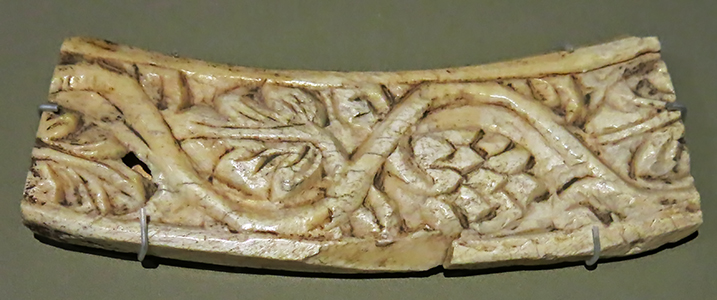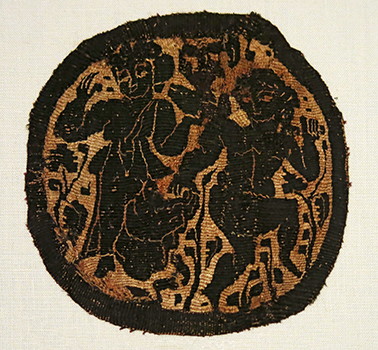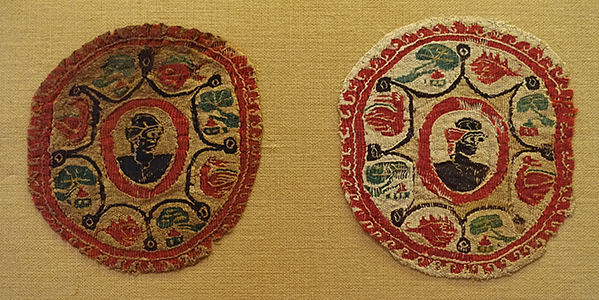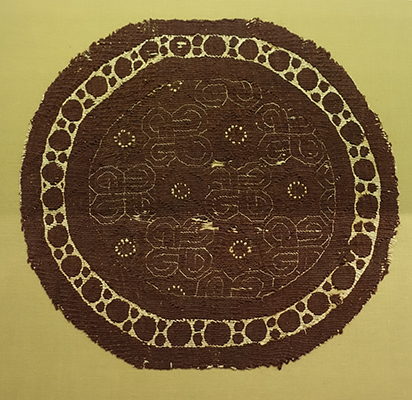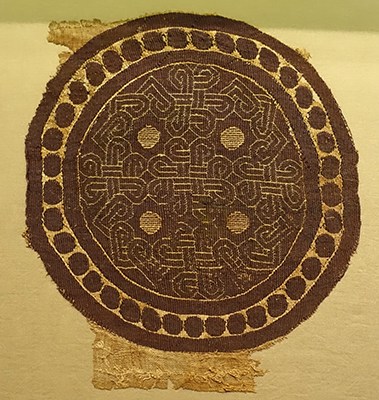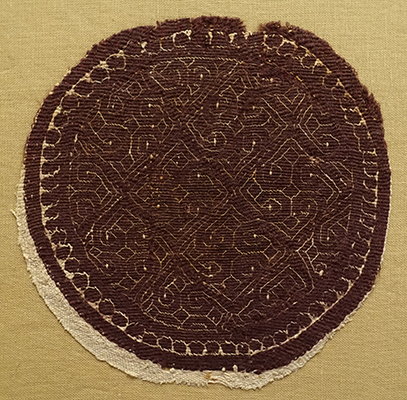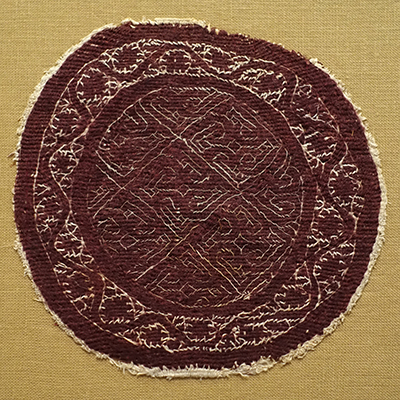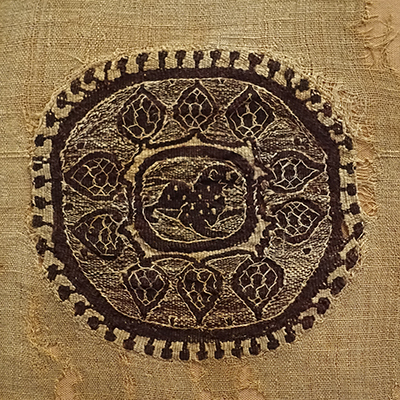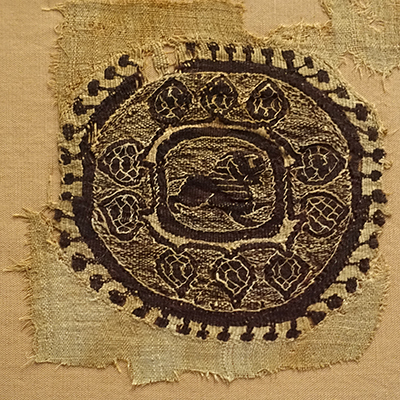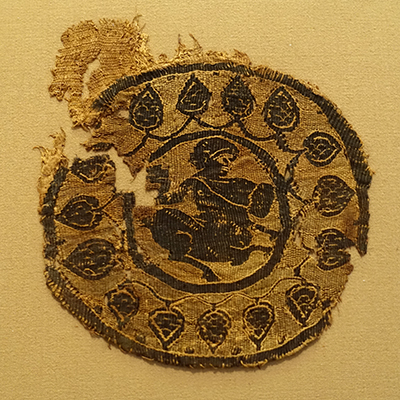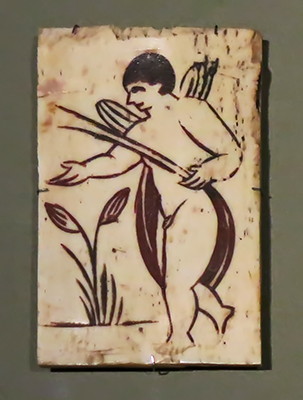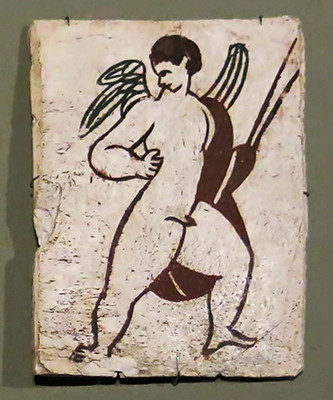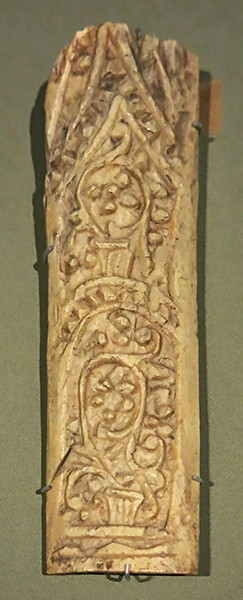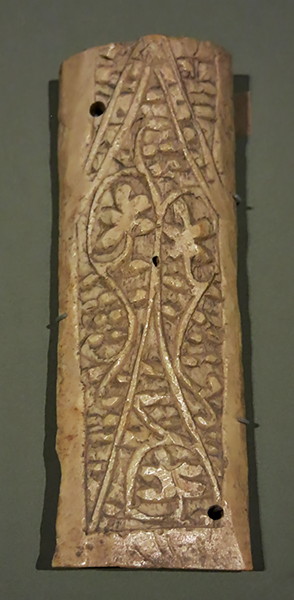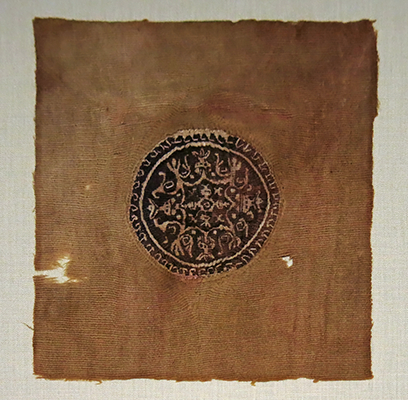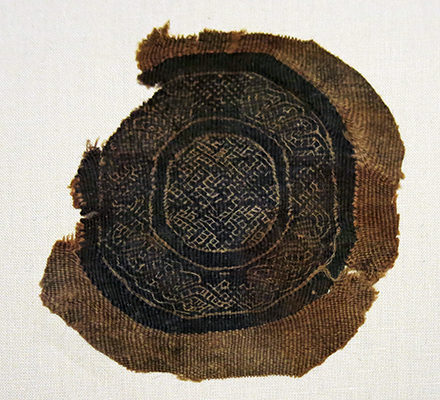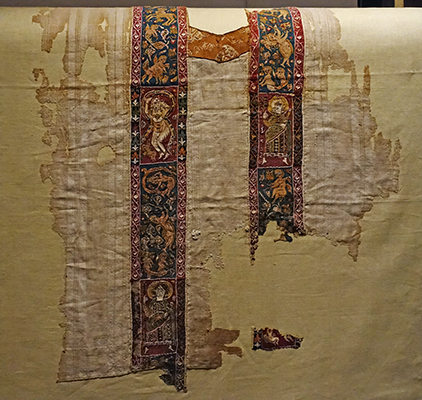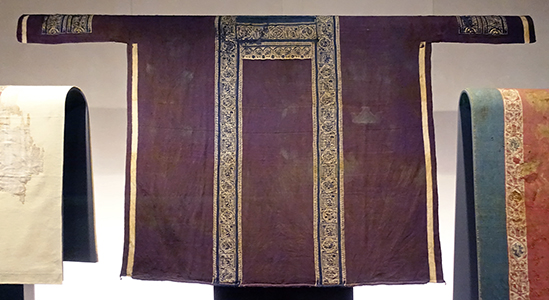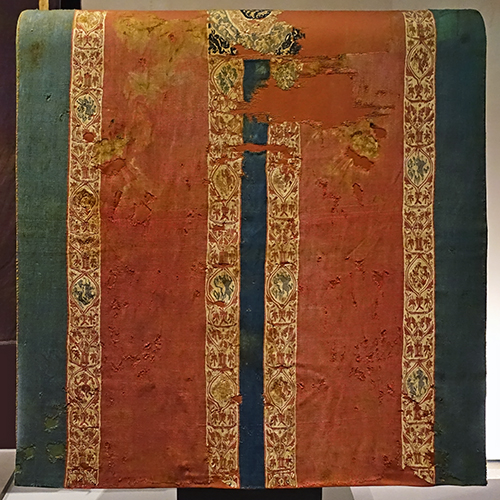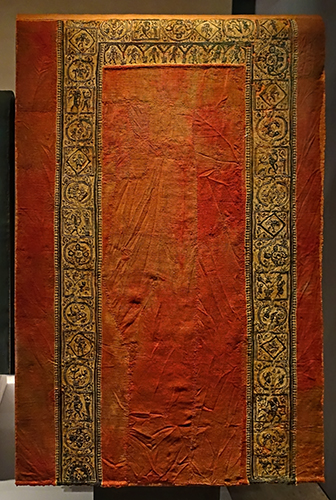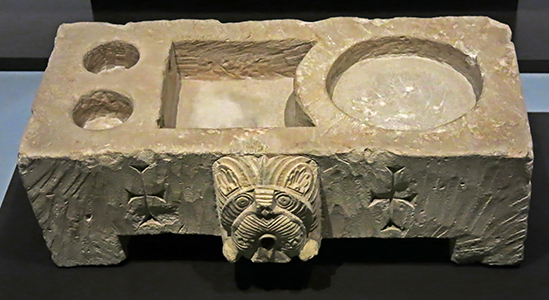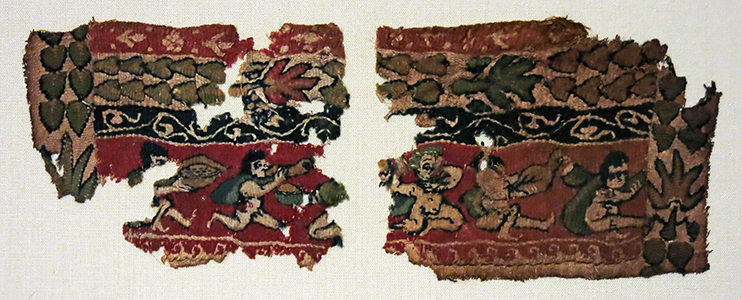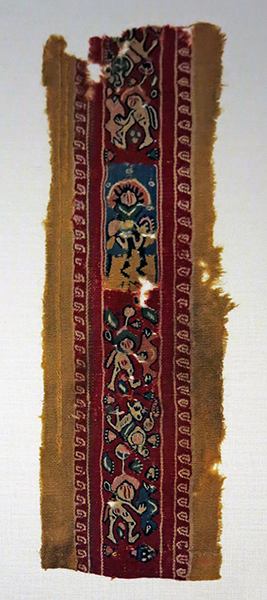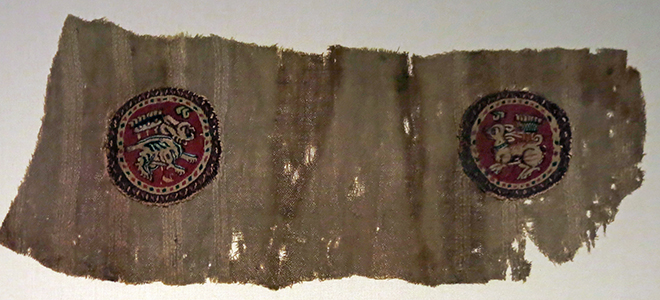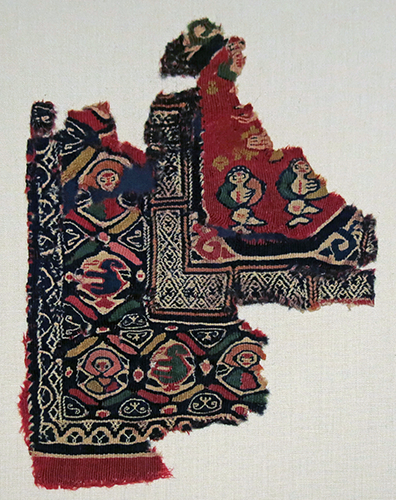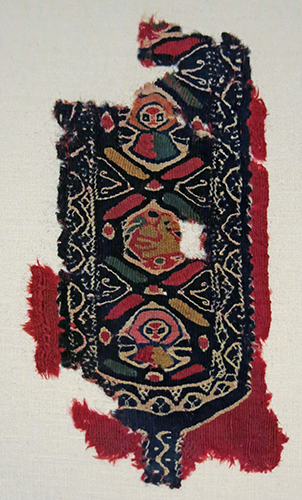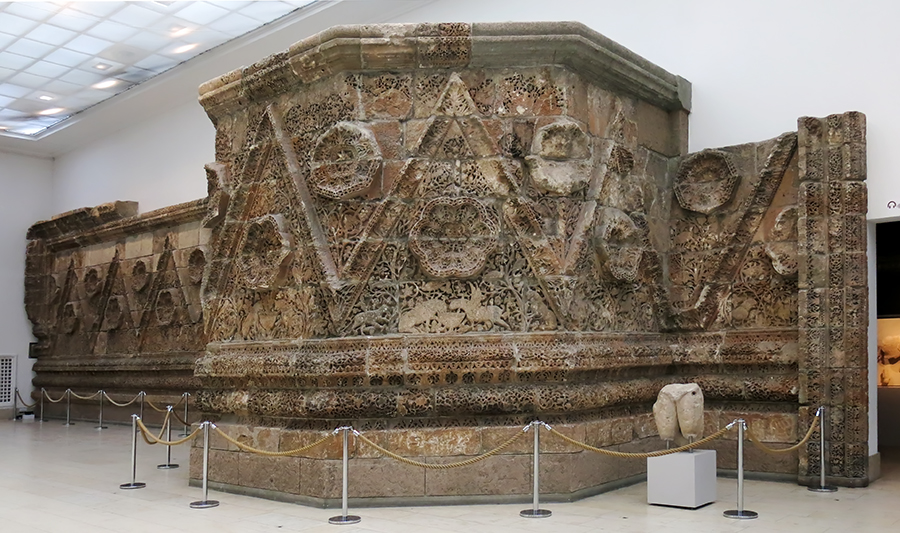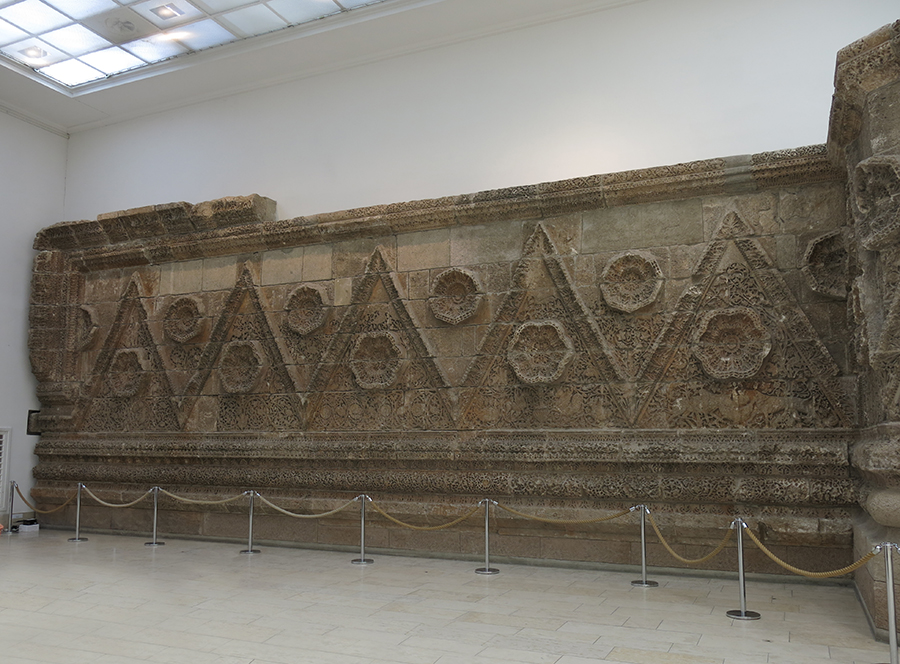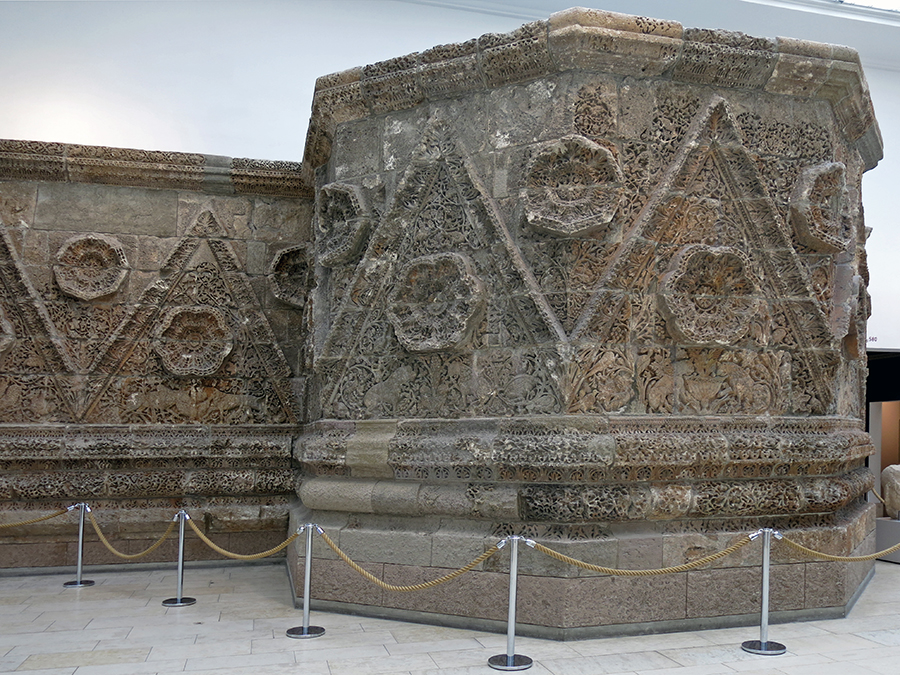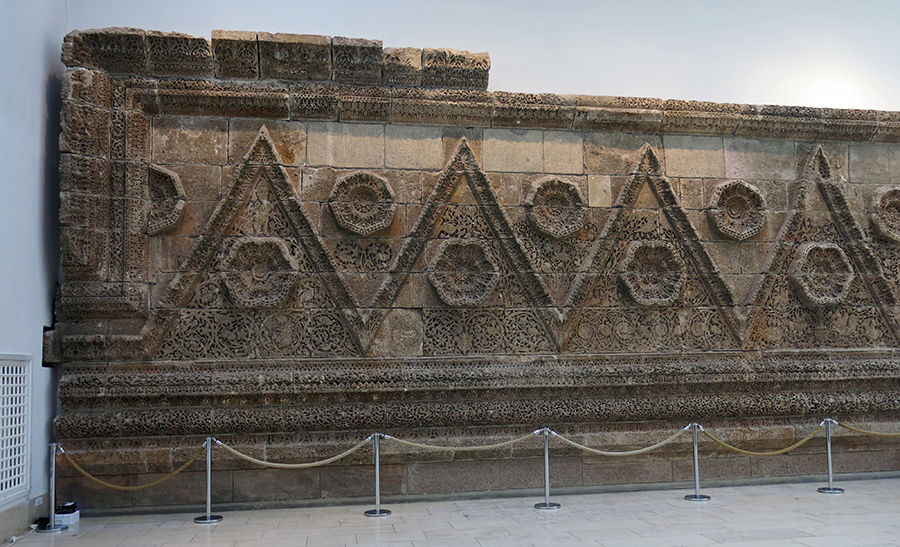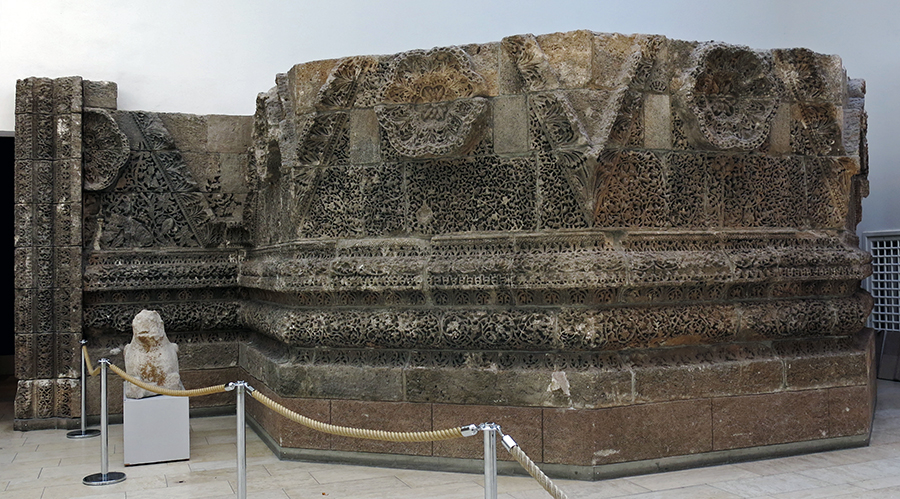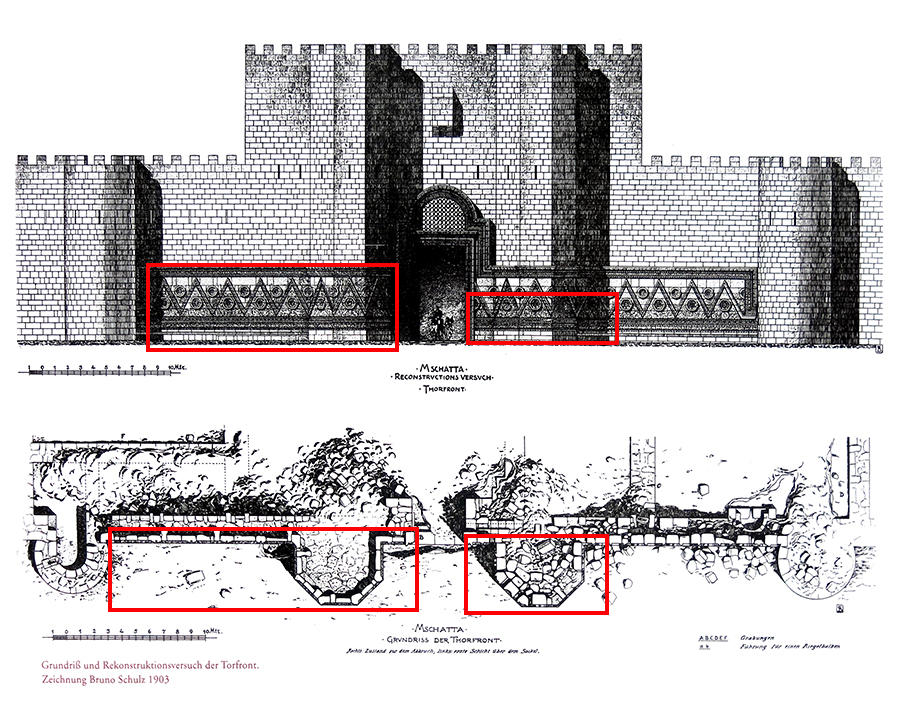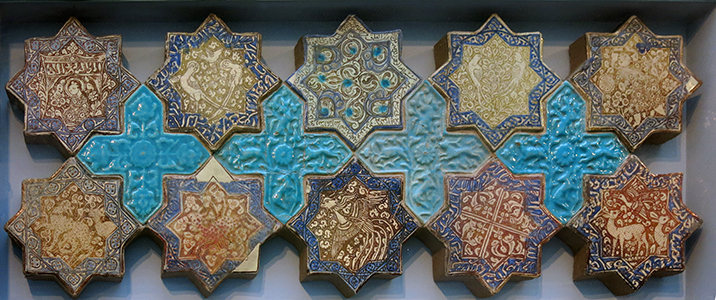Back to Don's Maps
 Back to Archaeological Sites
Back to Archaeological Sites
 Back to Egypt Index Page
Back to Egypt Index Page
Coptic and Islamic textiles and other art works
from Egypt and neighbouring areas
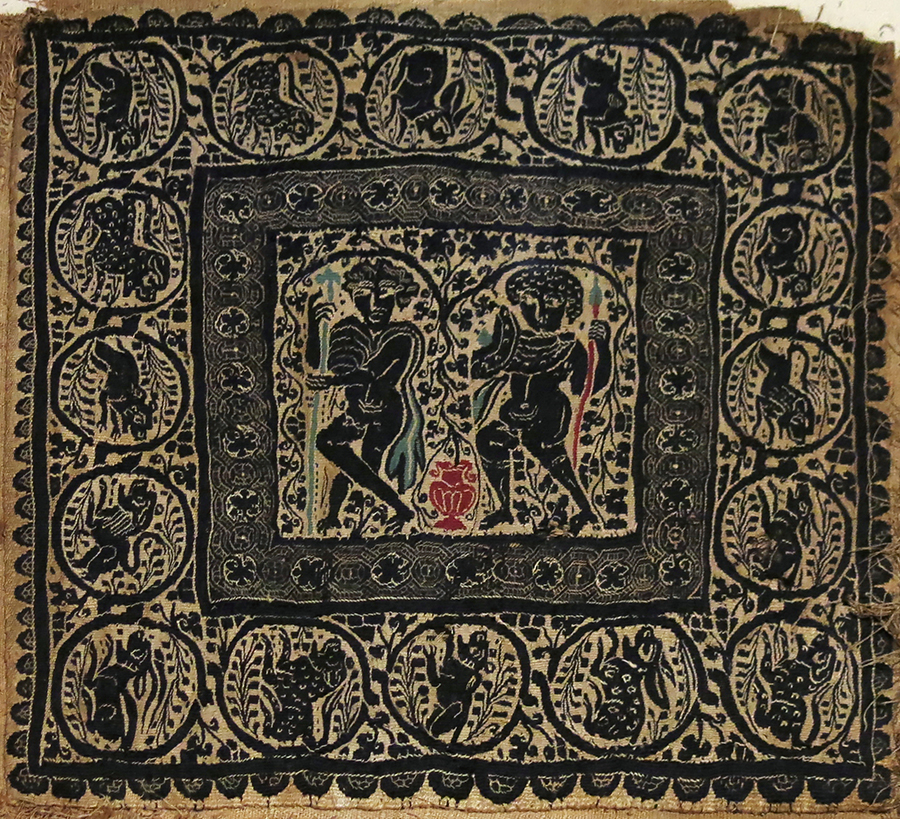
Cushion cover
Cushion with a decorative panel: two men among grapevines, framed by animal medallions, 5th century AD.
Catalog: Linen, Antinoöpolis, ÄS 4287
Photo: Don Hitchcock 2015
Source: Original, Ägyptischen Museum München
Text: © Ägyptischen Museum München
Great credit should be given to the master craftspeople from the Ägyptischen Museum München who have put this exhibition together. Their artistry and technical skills are without peer.
I am staggered at the knowledge of woven and decorated textiles that the exhibitors have demonstrated in this world class exposition. Visitors to this page should examine carefully the way that the people responsible have used art concealing art - most of the woven textiles have had to be extremely carefully stretched, positioned and mounted on carefully chosen suitable substrates, to give the best possible presentation, thus hiding to some extent the knowledge and supreme technical and artistic skills necessary to display the textiles to best effect, so that it appears effortless. In many cases it is very difficult to see where the original textile leaves off and the backing begins, to complete the whole. These people are professionals, and it shows. Equally impressive are the superb displays of Coptic textiles at the Louvre in Paris - Don
A remarkable number of Coptic textiles survive today, due to the Coptic custom of burying them with the dead, and to the aridity of Egyptian graves. The textiles are commonly linen or wool and use the colours red, blue, yellow, green, purple, black and brown. The dyes were derived from madder, indigo, woad, saffron, the murex shell, and the kermes insect.Text above: Wikipedia
The first looms used were horizontal low-warp; vertical high-warp looms were introduced later. The basic garment was the tunic, which would become the dalmatic, a wide-sleeved long, loose vestment open at the sides. Some tunics were woven in one piece. They were decorated by clavi, vertical strips of ornamentation, a stylistic import from Rome.
Some fine examples of the Coptic textile are shown in museums all over the world and a large collection is in the Coptic Museum in Coptic Cairo. Tens of thousands of coloured fragments found their way into the museums of the world, especially after 1889 when the French archaeologist Albert Gayet published a catalogue of Coptic art and, in the Bulaq Museum, staged the first exhibition of Coptic monuments.
The early Coptic textiles still produced pictures and decoration incorporating Egyptian and Greek motifs. Shrouds, for example, might incorporate classical elements painted in the form of an Egyptian sarcophagus and include representations of Egyptian gods to protect the dead. Later coptic textiles showed the influence of Byzantium and later, Islamic art.
Egyptian Chronology
| Egyptian Chronology | ||
|---|---|---|
| Date | Culture | Duration |
| 11 000 BC | Jebel Sahaba | |
| Before 8 000 BC - Palaeolithic in Europe and Northern Asia | ||
| 8 000 BC - Nominal end of the Ice Age | ||
| 8 600 - 4 400 BC | Nabta Playa Neolithic | 4 200 years |
| 6 100 - 5 180 BC | Qarunian (formerly known as Fayum B) | 920 years |
| 5 200 - 4 200 BC | Fayum A | 1 000 years |
| 4 800 - 4 200 BC | Merimde | 600 years |
| 4 600 - 4 400 BC | El Omari | 200 years |
| 4 400 - 4 000 BC | Badarian | 400 years |
| 4 000 - 3 300 BC | Maadi | 700 years |
| 4 000 - 3 500 BC | Naqada I | 500 years |
| 3 500 - 3 200 BC | Naqada II | 300 years |
| 3 200 - 3 100 BC | Naqada III | 100 years |
| 3 100 - 2 670 BC | Early Dynastic | 586 years |
| 2 670 - 2 181 BC | Old Kingdom | 505 years |
| 2 181 - 2 025 BC | First Intermediate Period | 156 years |
| 2 025 - 1 700 BC | Middle Kingdom | 325 years |
| 1 700 - 1 550 BC | Second Intermediate Period | 150 years |
| 1 550 - 1 077 BC | New Kingdom | 473 years |
| 1 077 - 664 BC | Third Intermediate Period | 413 years |
| 664 - 332 BC | Late Period | 332 years |
| 525 - 404 BC | First Persian Period | 121 years |
| 404 - 343 BC | Late Dynastic Period | 61 years |
| 343 - 332 BC | Second Persian Period | 11 years |
| 332 - 305 BC | Macedonian Period | 27 years |
| 305 - 30 BC | Ptolemaic Period | 275 years |
| 30 BC - 395 AD | Roman Period | 425 years |
| 395 AD - 640 AD | Byzantine Period | 245 years |
| 640 AD - 1517 AD | Islamic Period | 877 years |
| 1517 AD - 1867 AD | Ottoman Period (French Occupation 1798-1801) |
350 years |
| 1867 AD - 1914 AD | Khedival Period | 47 years |
| 1914 AD - 1922 AD | Sultanate under Hussein Kamel, as a British Protectorate |
8 years |
| 1922 AD - 1953 AD | Monarchy | 31 years |
| 1953 AD - Present Day | Republic | |
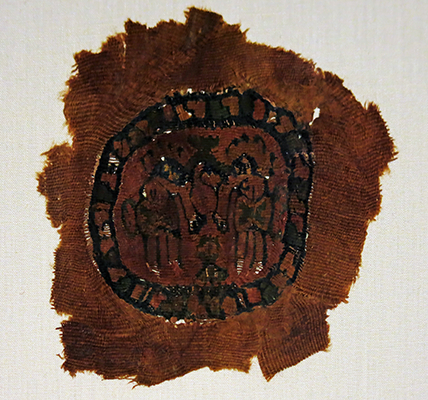
Coptic period: 3rd - 8th centuries AD
Medallion
Fragment from a tunic: medallion with two standing men (?) with nimbi, 3rd - 4th century AD.
( A nimbus is a luminous cloud or halo about a god or goddess when on earth - Don )
Catalog: Wool, ÄS 7251
Photo: Don Hitchcock 2015
Source: Original, Ägyptischen Museum München
Text: © Ägyptischen Museum München

Coptic period: 3rd - 8th centuries AD
Moulding
Moulding, a double grape vine with leaves and bunches of grapes, 3rd - 4th centuries AD.
Catalog: Bone, ÄS 5935
Photo: Don Hitchcock 2015
Source: Original, Ägyptischen Museum München
Text: © Ägyptischen Museum München
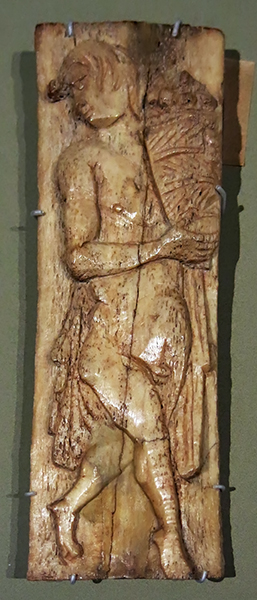
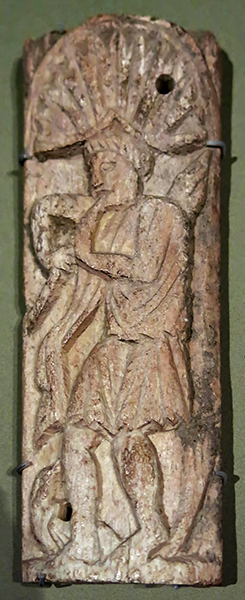
Coptic period: 3rd - 8th centuries AD
Relief Panels
Relief panels: young man with a basket of fruit, shepherd playing the flute, 3rd - 5th centuries AD.
Catalog: Bone, ÄS 5925, ÄS 5923
Photo: Don Hitchcock 2015
Source: Original, Ägyptischen Museum München
Text: © Ägyptischen Museum München
Coptic period: 3rd - 8th centuries AD
Moulding
Moulding with scrollwork, 3rd - 5th centuries AD.
Catalog: Bone, ÄS 5933
Photo: Don Hitchcock 2015
Source: Original, Ägyptischen Museum München
Text: © Ägyptischen Museum München
Coptic period: 3rd - 8th centuries AD
Oil Lamps
Five oil lamps with various ornamentations, including floral, 3rd - 5th centuries AD.
( The lamp at centre foreground appears to have been sprigged, a technique for decorating pottery with low relief shapes made separately from the main body, often from moulds, and applied to it before firing - Don )
Catalog: Ceramic, ÄS 374, ÄS 376, ÄS 1771, ÄS 2500, ÄS 2501
Photo: Don Hitchcock 2015
Source: Original, Ägyptischen Museum München
Text: © Ägyptischen Museum München
Additional text: Wikipedia

Coptic period: 3rd - 8th centuries AD
Moulding
Moulding with scrollwork, 3rd - 5th centuries AD.
Catalog: Bone, ÄS 5931
Photo: Don Hitchcock 2015
Source: Original, Ägyptischen Museum München
Text: © Ägyptischen Museum München
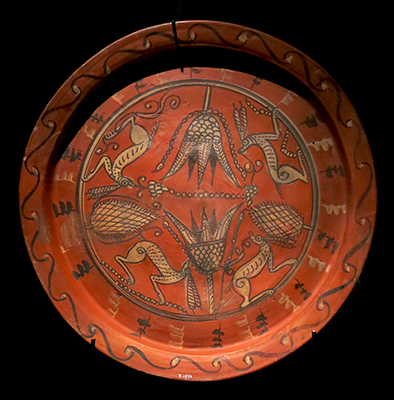
Coptic period: 3rd - 8th centuries AD
Plate
Plate with hares, 3rd - 6th centuries AD.
Terra sigillata, pottery with a glossy red slip applied to the surface.
Catalog: Ceramic ÄS 3992
Photo: Don Hitchcock 2015
Source: Original, Ägyptischen Museum München
Text: © Ägyptischen Museum München
Additional text: Wikipedia
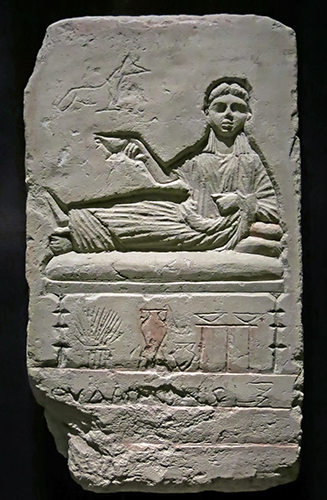
Coptic period: 3rd - 8th centuries AD
Stela of Eudaimonis.
Stela of Eudaimonis shown reclining on a couch, with the god Anubis, circa 300 AD.
( Eudaimonia is a Greek word meaning good spirit or happiness - Don )
Catalog: Limestone, Terenuthis, ÄS 4291
Photo: Don Hitchcock 2015
Source: Original, Ägyptischen Museum München
Text: © Ägyptischen Museum München
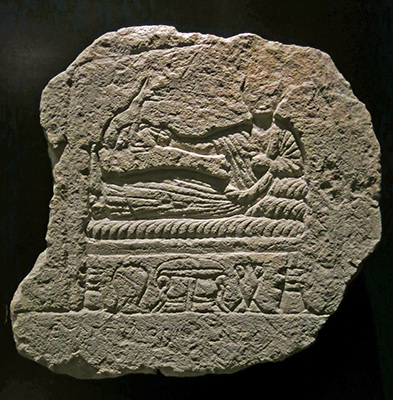
Coptic period: 3rd - 8th centuries AD
Stela of Euvangelos
Stela of Euvangelos shown reclining on a couch, with the god Anubis, circa 300 AD.
Catalog: Limestone, Terenuthis, Gl. 140
Photo: Don Hitchcock 2015
Source: Original, Ägyptischen Museum München
Text: © Ägyptischen Museum München
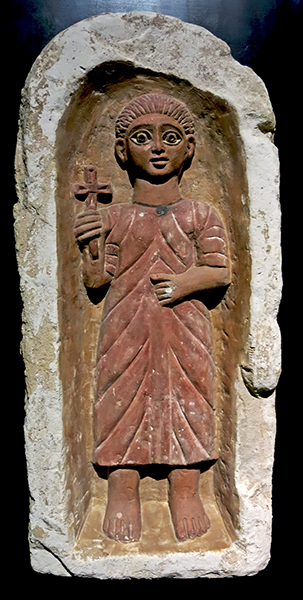
Coptic period: 3rd - 8th centuries AD
Tomb Stela
Tomb stela - a youth framed by a niche with a round arch, late 4th century AD.
Height 655 mm, width 285 mm.
Catalog: Limestone, Antinoöpolis, ÄS 5529
Photo: Don Hitchcock 2015
Source: Original, Ägyptischen Museum München
Text: © Ägyptischen Museum München
Additional information: Wikipedia
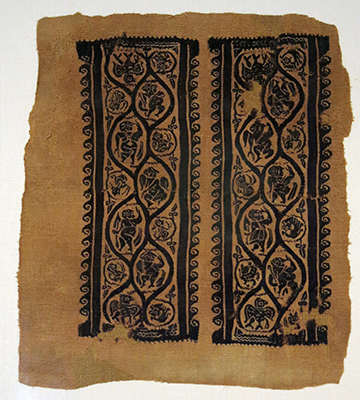
Coptic period: 3rd - 8th centuries AD
Sea Nymphs
Fragment of a sleeve with a double trim: riding Nereids, Sea Nymphs, 4th - 5th centuries AD.
( Nereids were sea nymphs from Greek mythology, who helped sailors in danger on the seas - Don )
Catalog: Wool on linen, ÄS 6044
Photo: Don Hitchcock 2015
Source: Original, Ägyptischen Museum München
Text: © Ägyptischen Museum München
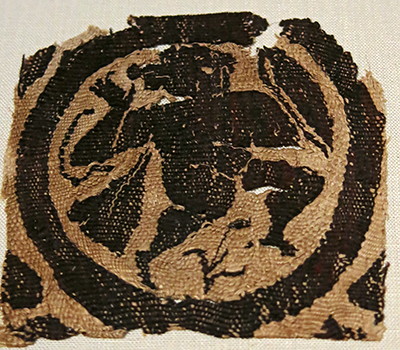
Coptic period: 3rd - 8th centuries AD
Medallion
Medallion with dancing Erote, 4th - 5th centuries AD.
The Erotes are a group of winged gods associated with love and sex in Greek mythology.
Catalog: Wool and linen, ÄS 7239
Photo: Don Hitchcock 2015
Source: Original, Ägyptischen Museum München
Text: © Ägyptischen Museum München
Additional text: Wikipedia
Coptic period: 3rd - 8th centuries AD
Medallions
Two Medallions with dancing pairs among grapevines (bucolic motif), 4th - 5th centuries AD.
Catalog: Wool and linen, ÄS 7242, ÄS 5964
Photo: Don Hitchcock 2015
Source: Original, Ägyptischen Museum München
Text: © Ägyptischen Museum München
Coptic textiles, whose production began in the third and fourth centuries AD in Egypt, were hand woven with unbleached linen warps and dyed wool wefts and frequently featured woollen tapestry decoration. Men's garments were done in sedate colours with monochrome interlace motifs while women favoured floral and figural decorations. During the Early Coptic period (3rd - 4th centuries AD) , the primary decorative themes were taken from nature and mythology. By the middle period (5th - 7th centuries AD), depictions included abstract natural elements and Christian symbolism.Text above: Deacon & McFarland (2014)
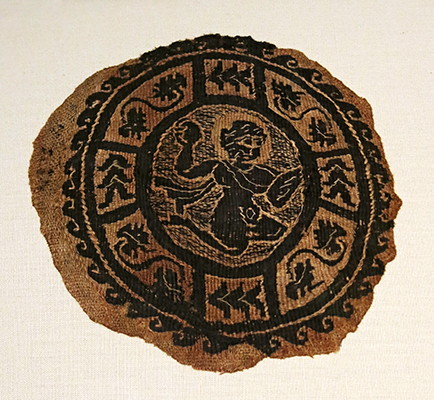
Coptic period: 3rd - 8th centuries AD
Medallion
Orphrey (highly detailed embroidery, in which typically simple materials are made into complex patterns) from a tunic: medallion showing a kneeling man with a halo, 4th - 5th centuries AD.
Catalog: Wool and linen, ÄS 5984
Photo: Don Hitchcock 2015
Source: Original, Ägyptischen Museum München
Text: © Ägyptischen Museum München
Additional text: Wikipedia
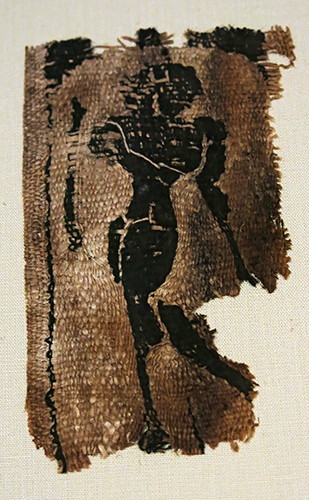
Coptic period: 3rd - 8th centuries AD
Maenad
Fragment of a tunic with a dancing Maenad, 4th - 5th centuries AD.
In Greek mythology, maenads were the female followers of Dionysus and the most significant members of the Thiasus, the god's retinue. Their name literally translates as 'raving ones'. Maenads were known as Bassarids, Bacchae, or Bacchantes in Roman mythology after the penchant of the equivalent Roman god, Bacchus, to wear a bassaris or fox-skin.
Often the maenads were portrayed as inspired by Dionysus into a state of ecstatic frenzy through a combination of dancing and intoxication. During these rites, the maenads would dress in fawn skins and carry a thyrsus, a long stick wrapped in ivy or vine leaves and tipped with a pine cone. They would weave ivy-wreaths around their heads or wear a bull helmet in honour of their god, and often handle or wear snakes.
These women were mythologised as the 'mad women' who were nurses of Dionysus in Nysa: Lycurgus 'chased the Nurses of the frenzied Dionysus through the holy hills of Nysa, and the sacred implements dropped to the ground from the hands of one and all, as the murderous Lycurgus struck them down with his ox-goad'. They went into the mountains at night and practiced strange rites.
Catalog: Wool and linen on linen, ÄS 7248
Photo: Don Hitchcock 2015
Source: Original, Ägyptischen Museum München
Text: © Ägyptischen Museum München
Additional text: Wikipedia

Coptic period: 3rd - 8th centuries AD
Medallion from a Tunic
Medallion from a tunic: winged genius (god) within a wreath of fish and aquatic plants, 4th - 5th centuries AD.
( note that although this is catalogued as wool, it looks more like linen that has been painted with a design - Don )
Catalog: Wool, Ashmunein, ÄS 5988
Photo: Don Hitchcock 2015
Source: Original, Ägyptischen Museum München
Text: © Ägyptischen Museum München
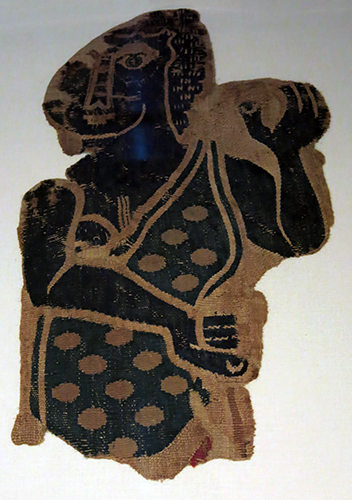
Coptic period: 3rd - 8th centuries AD
Figure in Furs
Fragment of a drapery with a standing figure clothed in furs (shepherd?), 4th - 5th centuries AD.
Catalog: Wool on linen, ÄS 5963
Photo: Don Hitchcock 2015
Source: Original, Ägyptischen Museum München
Text: © Ägyptischen Museum München
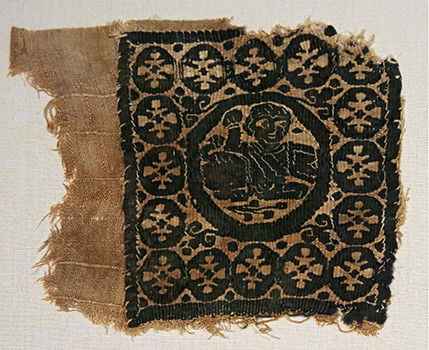
Coptic period: 3rd - 8th centuries AD
Orphrey from a Tunic
Orphrey from a tunic: centaur framed by cross elements, 4th - 5th centuries AD.
Catalog: Wool on linen, ÄS 7246
Photo: Don Hitchcock 2015
Source: Original, Ägyptischen Museum München
Text: © Ägyptischen Museum München
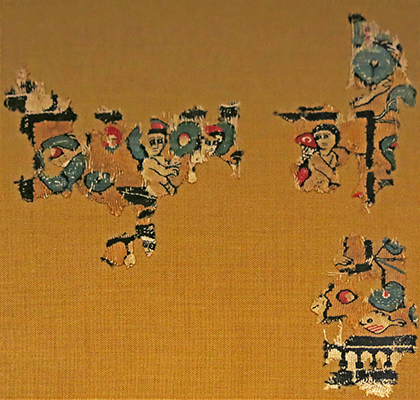
Coptic period: 3rd - 8th centuries AD
Angler
Trim with a line fisherman, framed by a decorative wave scroll frieze, 4th - 5th centuries AD.
Catalog: Wool on linen, ÄS 5561
Photo: Don Hitchcock 2015
Source: Original, Ägyptischen Museum München
Text: © Ägyptischen Museum München
Coptic period: 3rd - 8th centuries AD
Portraits in a Nilotic setting
These almost identical medallions decorated a linen tunic.
Fish, birds and lotus evoke the environment of the banks of the Nile, 4th - 5th century AD.
Catalog: Linen and wool, tapestry, Antinoöpolis, Egypt, excavations A. Gayet, early 20th century, E 28851, AF 5447
Photo: Don Hitchcock 2018
Source: Original, Musée du Louvre
Text: © Card at Musée du Louvre
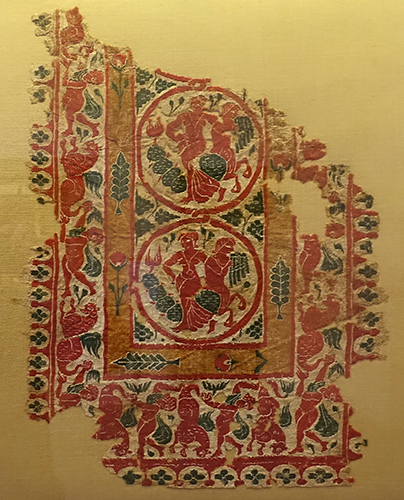
Coptic period: 3rd - 8th centuries AD
Tritons and nereids
In the medallions framed by vine tendrils, a triton plays the Pan flute for his companion, one of the fifty daughters of the Greek god Nereus.
Together with the sea creatures in the frame, they illustrate the persistence of Greek culture in late antiquity.
Inserted into a larger piece of fabric, this tapestry is the lower part of a vertical band that decorated a hanging in a rich Egyptian house, 4th - 5th century AD.
Catalog: Linen and wool, canvas (remnants on the sides) and tapestry, E 33414
Source: Original, Musée du Louvre
Text: © Card at Musée du Louvre
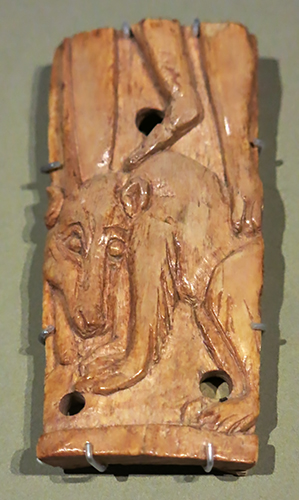
Coptic period: 3rd - 8th centuries AD
Relief Panel
Relief panel: Hunter with a bear, 4th - 6th centuries AD.
Catalog: Bone, ÄS 5916
Photo: Don Hitchcock 2015
Source: Original, Ägyptischen Museum München
Text: © Ägyptischen Museum München
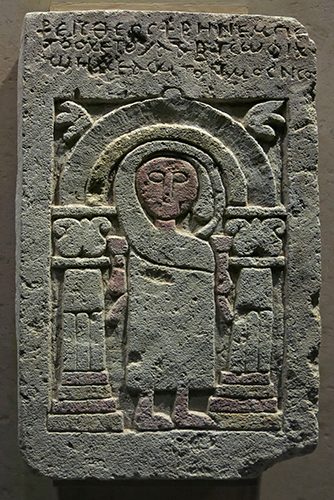
Coptic period: 3rd - 8th centuries AD
Coptic Saint
Stela with the image of a saint in a niche, 4th - 6th centuries AD.
Catalog: Sandstone, gift of the Staatliches Museum für Völkerkunde München
Photo: Don Hitchcock 2015
Source: Original, Ägyptischen Museum München
Text: Museum card, © Ägyptischen Museum München
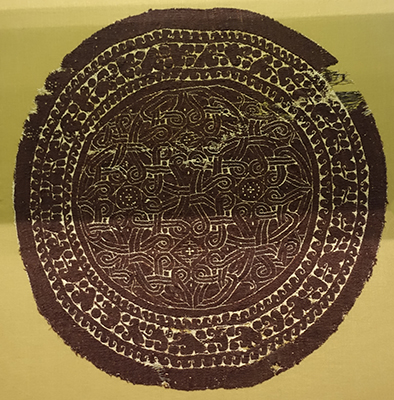
Coptic period: 3rd - 8th centuries AD
Three Large Medallions
In a decorated frame, the dark disc is crossed by thin white lines. These drawings were made at the same time as the tapestry, by means of a 'flying' linen thread, i.e. free to jump over the wefts and go in all directions, 4th - 6th centuries AD.
Catalog: Linen and wool, tapestry, Donation Mayer, AF 6149, AF 5644, excavations Albert Gayet in Antinoöpolis, beginning of the 20th century, E 28947
Photo: Don Hitchcock 2018
Source: Original, Musée du Louvre
Text: © Card at Musée du Louvre, http://cartelfr.louvre.fr/

Coptic period: 3rd - 8th centuries AD
Three Small Medallions
Used as decorations for tunics or cushions, these medallions are embellished with complex geometric patterns executed in linen thread, in a technique that gives the weaver the freedom to draw sinuous and interlacing contours, 4th - 6th centuries AD.
Catalog: Linen and wool, tapestry, Akhmim, 1886, Don Nicolas Tano: AF 5657, AF 5881, E 10205
Photo: Don Hitchcock 2018
Source: Original, Musée du Louvre
Text: © Card at Musée du Louvre, http://cartelfr.louvre.fr/
Coptic period: 3rd - 8th centuries AD
Small Medallions
Small medallions, decorations for a tunic, and remnants of the linen support. The medallions were attached in pairs and were placed at the shoulders at the front and the back of the garment.
In the leaf-decorated frames are animals, 4th - 6th centuries AD.
Catalog: Linen and wool, tapestry, Antinoöpolis, Egypt, excavations A. Gayet, early 20th century E 29237, E 29260
Photo: Don Hitchcock 2018
Source: Original, Musée du Louvre
Text: © Card at Musée du Louvre, http://cartelfr.louvre.fr/
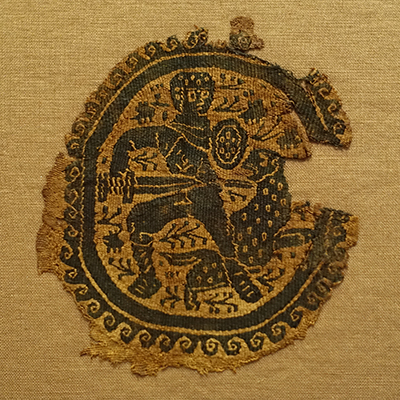
Coptic period: 3rd - 8th centuries AD
Small Medallion
Small medallion, decoration for a tunic, and remnants of the linen support. The medallions were attached in pairs and were placed at the shoulders at the front and the back of the garment.
The man killing a feline is probably a wild animal fighter in the circus games, 4th - 6th centuries AD.
Catalog: Linen and wool, tapestry, Antinoöpolis, Egypt, excavations A. Gayet, early 20th century, E 29016
Photo: Don Hitchcock 2018
Source: Original, Musée du Louvre
Text: © Card at Musée du Louvre
Coptic period: 3rd - 8th centuries AD
Small Medallion
Tiny medallion, decoration for a tunic, and remnants of the linen support.
The medallion contains a cherub, and is extended in width by foliage, 4th - 6th centuries AD.
Catalog: Linen and wool, tapestry, Antinoöpolis, Egypt, excavations A. Gayet, early 20th century, E 29064
Photo: Don Hitchcock 2018
Source: Original, Musée du Louvre
Text: © Card at Musée du Louvre
Coptic period: 3rd - 8th centuries AD
Tunic Decoration
Taken from Greek mythology, the image of the centaur, half man, half horse, was adopted into Roman and then Byzantine Egypt, 4th - 6th centuries AD.
Catalog: Linen and wool, tapestry, Antinoöpolis, Egypt, excavations A. Gayet, early 20th century, E 29018
Photo: Don Hitchcock 2018
Source: Original, Musée du Louvre
Text: © Card at Musée du Louvre
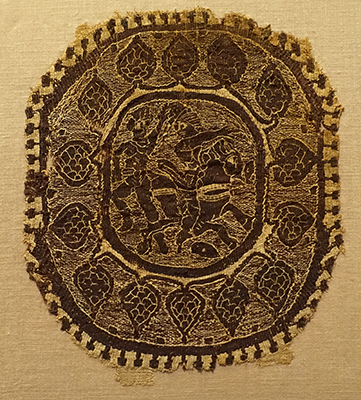
Coptic period: 3rd - 8th centuries AD
Medallion
This medallion was undescribed by a museum card, but appears to show a foot soldier and a cavalryman in combat, 4th - 6th centuries AD.
Catalog: Linen and wool, tapestry, unknown inventory number
Photo: Don Hitchcock 2018
Source: Original, Musée du Louvre
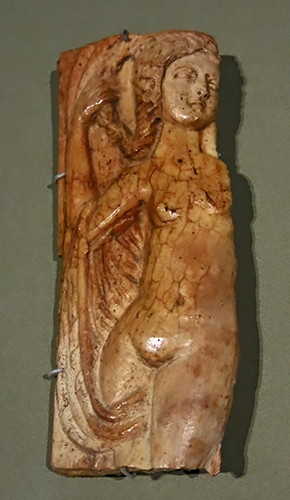
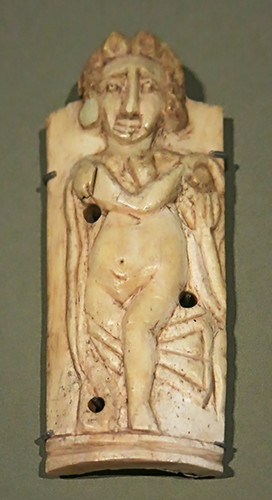
Coptic period: 3rd - 8th centuries AD
Relief panels
Depictions of the goddess Aphrodite, 4th - 6th centuries AD.
( the sculpture on the left is very well done, but if the relief panel on the right was meant to be an erotic depiction of Aphrodite, the sculptor has failed miserably - Don )
Catalog: Bone, Alexandria, ÄS 4225, ÄS 5859
Photo: Don Hitchcock 2015
Source: Original, Ägyptischen Museum München
Text: © Ägyptischen Museum München
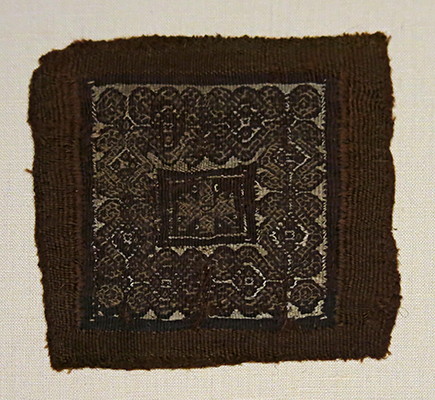
Coptic period: 3rd - 8th centuries AD
Orphrey
Orphrey, a cross framed by arabesques., 4th - 6th centuries AD.
Catalog: Wool on linen, Schech Abade, Antinoöpolis, Egypt, ÄS 5985
Photo: Don Hitchcock 2015
Source: Original, Ägyptischen Museum München
Text: © Ägyptischen Museum München
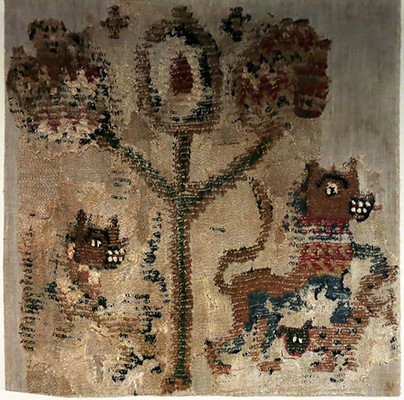
Coptic period: 3rd - 8th centuries AD
Wall hanging
Fragment of a wall hanging, with lions and floral elements, 4th - 6th centuries AD.
Catalog: Wool on Linen
Photo: Don Hitchcock 2015
Source: Original, Ägyptischen Museum München
Text: © Ägyptischen Museum München
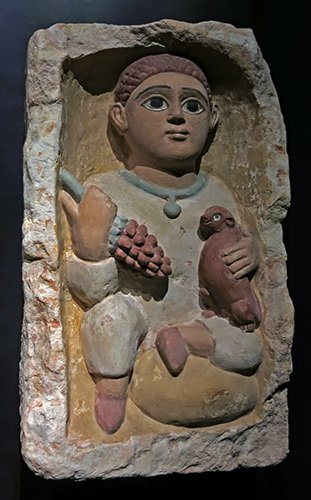
Coptic period: 3rd - 8th centuries AD
Boy with Grapes
Boy with a cluster of grapes and a small dog, fourth century AD.
Catalog: Limestone, Antinoöpolis, ÄS 4860
Photo: Don Hitchcock 2015
Source: Original, Ägyptischen Museum München
Text: Museum card, © Ägyptischen Museum München
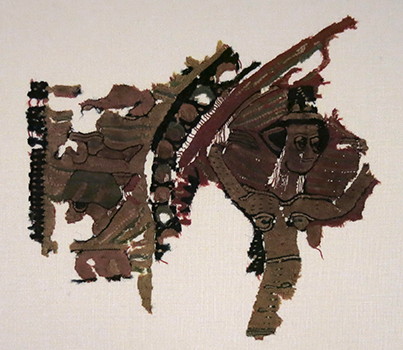
Coptic period: 3rd - 8th centuries AD
Wall hanging
Fragment of a wall hanging, with a female figure, 4th - 6th centuries AD.
Catalog: Wool, ÄS 6045
Photo: Don Hitchcock 2015
Source: Original, Ägyptischen Museum München
Text: © Ägyptischen Museum München
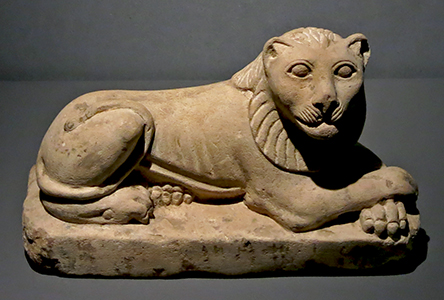
Coptic period: 3rd - 8th centuries AD
Reclining lion
Sculpture of a reclining lion, 4th - 6th centuries AD.
Catalog: Limestone, Behnasa (?), ÄS 4185
Photo: Don Hitchcock 2015
Source: Original, Ägyptischen Museum München
Text: © Ägyptischen Museum München
Coptic period: 3rd - 8th centuries AD
Furniture inlays
Three furniture inlays with genii (deities) of the seasons, 4th - 6th centuries AD.
Catalog: Bone, ÄS 5861, ÄS 5862, ÄS 5863
Photo: Don Hitchcock 2015
Source: Original, Ägyptischen Museum München
Text: © Ägyptischen Museum München
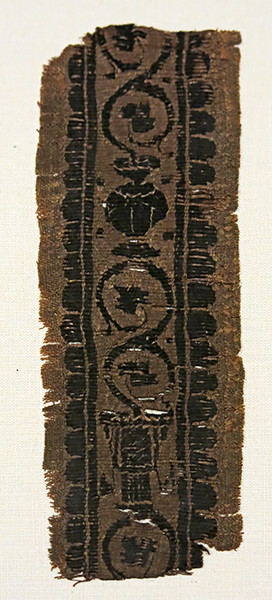
Coptic period: 3rd - 8th centuries AD
Tunic fragment
Fragment of a tunic, vases among grapevines, 4th - 6th centuries AD.
Catalog: Wool on linen, ÄS 61c
Photo: Don Hitchcock 2015
Source: Original, Ägyptischen Museum München
Text: © Ägyptischen Museum München
Coptic period: 3rd - 8th centuries AD
Mouldings
Mouldings with grapevines, 4th - 6th centuries AD.
Catalog: Bone, ÄS 5936, ÄS 5937, ÄS 5938
Photo: Don Hitchcock 2015
Source: Original, Ägyptischen Museum München
Text: © Ägyptischen Museum München
Coptic period: 3rd - 8th centuries AD
Mouldings
Mouldings with grapevines, 4th - 6th centuries AD.
Catalog: Bone, ÄS 5941, ÄS 5942
Photo: Don Hitchcock 2015
Source: Original, Ägyptischen Museum München
Text: © Ägyptischen Museum München
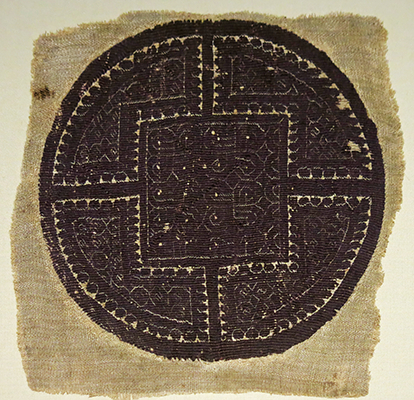
Coptic period: 3rd - 8th centuries AD
Orphreys
Orphreys from tunics: medallions with floral and ornamental patterns, 4th - 6th centuries AD.
Catalog: Wool and Linen, ÄS 688, ÄS 7240, ÄS 7241, ÄS 7245, ÄS 7250
Photo: Don Hitchcock 2015
Source: Original, Ägyptischen Museum München
Text: © Ägyptischen Museum München


Coptic period: 3rd - 8th centuries AD
Relief Panels
(left) Moulding with a cherub and bunches of grapes above a vase, 4th - 6th centuries AD.
(right) Moulding with a cherub and hare among grape vines, 4th - 6th centuries AD.
Catalog: Bone
(left) ÄS 5920
(right) ÄS 5919, ÄS 5932
Photo: Don Hitchcock 2015
Source: Original, Ägyptischen Museum München
Text: © Ägyptischen Museum München
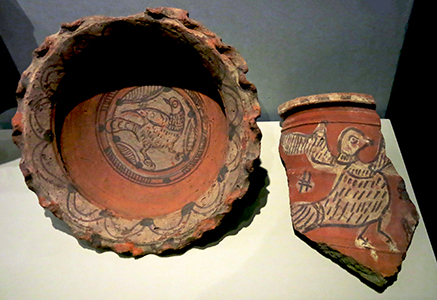
Coptic period: 3rd - 8th centuries AD
Deep Dish
Deep dish and potsherds with doves, 4th - 6th centuries AD.
( To my eyes this pottery is not of the high standard of much of Dynastic Egypt's ceramics, but the decoration is free and quite artistic - Don )
Catalog: Ceramic ÄS 4466, ÄS 3990
Photo: Don Hitchcock 2015
Source: Original, Ägyptischen Museum München
Text: © Ägyptischen Museum München
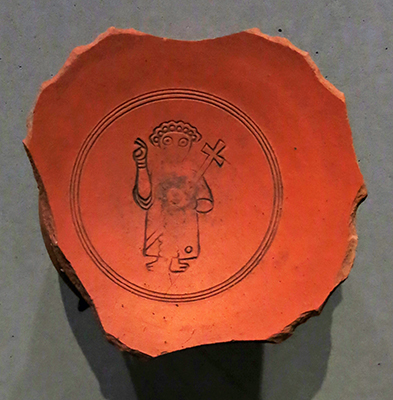
Coptic period: 3rd - 8th centuries AD
Christian Symbols
Potsherd bearing Christian symbols of the resurrection, showing Christ and the cross, 4th - 6th centuries AD.
Catalog: Ceramic ÄS 5971
Photo: Don Hitchcock 2015
Source: Original, Ägyptischen Museum München
Text: © Ägyptischen Museum München

Coptic period: 3rd - 8th centuries AD
Benediction
Standing figure of a young man making a gesture of benediction, 4th - 6th centuries AD.
Catalog: Ceramic ÄS 7256
Photo: Don Hitchcock 2015
Source: Original, Ägyptischen Museum München
Text: © Ägyptischen Museum München
Coptic period: 3rd - 8th centuries AD
Ecclesiastical clothes
Ecclesiastical clothes with woven orphreys, 4th - 6th centuries AD.
Catalog: Linen, wool, ÄS 4205 (Antinoöpolis), ÄS 4187, ÄS 5533, ÄS 62, ÄS 4204 (Antinoöpolis)
Photo: Don Hitchcock 2018
Source: Original, Ägyptischen Museum München
Text: © Ägyptischen Museum München
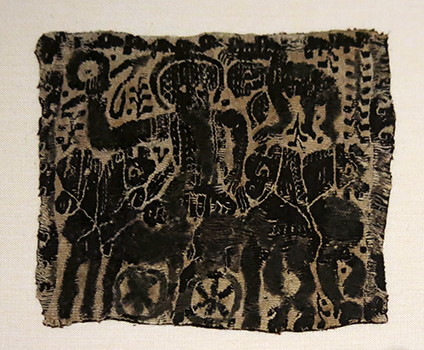
Coptic period: 3rd - 8th centuries AD
Orphrey from a tunic.
Orphrey from a tunic: Triumphator (one granted a triumph in ancient Rome) holding a victory wreath and driving a quadriga (chariot drawn by four horses abreast), with a putto (representation of a naked child), 5th century AD.
An orphrey is a highly detailed embroidery, in which typically simple materials are made into complex patterns.
Catalog: Wool on linen, ÄS 4236
Photo: Don Hitchcock 2015
Source: Original, Ägyptischen Museum München
Text: © Ägyptischen Museum München

Coptic period: 3rd - 8th centuries AD
Cushion cover
Cushion with a decorative panel: two men among grapevines, framed by animal medallions, 5th century AD.
Catalog: Linen, Antinoöpolis, ÄS 4287
Photo: Don Hitchcock 2015
Source: Original, Ägyptischen Museum München
Text: © Ägyptischen Museum München
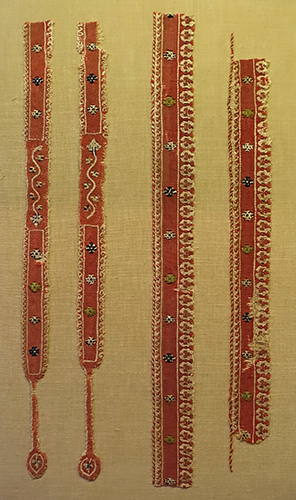
Coptic period: 3rd - 8th centuries AD
Strips from a Tunic
These bands, now cut out, were decorations on a woven linen tunic. The clavi descend from the shoulders to the chest and the back.
Their impressive delicacy, skill, and colour are remarkable, 5th century AD.
Catalog: Linen and wool, tapestry, Antinoöpolis, Egypt, excavations A. Gayet, early 20th century, AF 5506
Photo: Don Hitchcock 2018
Source: Original, Musée du Louvre
Text: © Card at Musée du Louvre
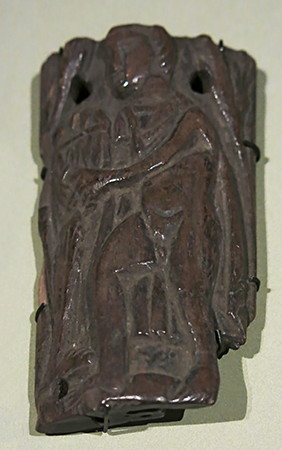
Coptic period: 3rd - 8th centuries AD
Relief panel
Shepherd with a basket of fruit, 5th century AD.
Catalog: Bone, ÄS 4219
Photo: Don Hitchcock 2015
Source: Original, Ägyptischen Museum München
Text: © Ägyptischen Museum München
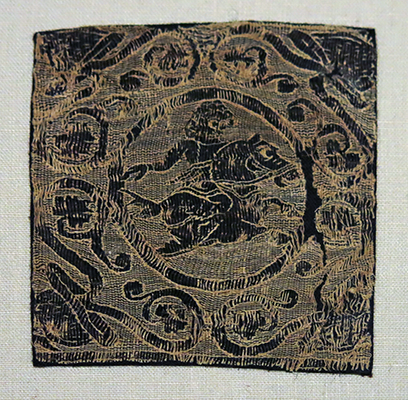
Coptic period: 3rd - 8th centuries AD
Orphrey
Orphrey from a tunic: medallion with a rider within a frieze of grapevines, 5th century AD.
Catalog: Wool and linen, ÄS 5562
Photo: Don Hitchcock 2015
Source: Original, Ägyptischen Museum München
Text: © Ägyptischen Museum München
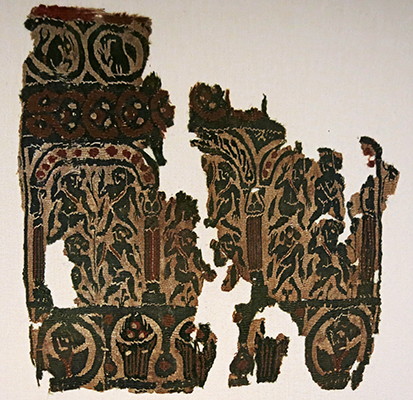
Coptic period: 3rd - 8th centuries AD
Tunic fragment
Fragment from the breast of a tunic with animals, and dancers beneath, 5th - 6th centuries AD.
Catalog: Wool and linen
Photo: Don Hitchcock 2015
Source: Original, Ägyptischen Museum München
Text: © Ägyptischen Museum München
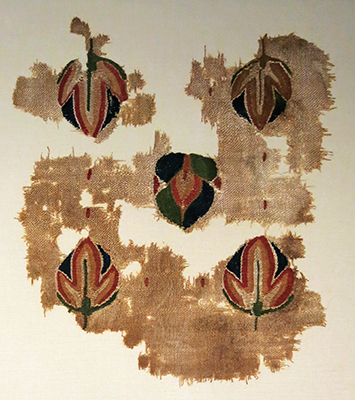
Coptic period: 3rd - 8th centuries AD
Wall Hanging or Coverlet
Wall hanging or coverlet, with a pattern of stemmed buds with three petals, 5th - 6th centuries AD.
Catalog: Wool on linen, Antinoöpolis, ÄS 4244
Photo: Don Hitchcock 2015
Source: Original, Ägyptischen Museum München
Text: © Ägyptischen Museum München

Coptic period: 3rd - 8th centuries AD
Decorated Panel
Fragment of a panel with stylised decoration - a red leaf, a fruit basket, and a green bird, 5th - 6th centuries AD.
Catalog: Wool on linen, ÄS 4266
Photo: Don Hitchcock 2015
Source: Original, Ägyptischen Museum München
Text: © Ägyptischen Museum München

Coptic period: 3rd - 8th centuries AD
Bucolic Scene
Trim with a bucolic scene, framed by doves and bunches of grapes, 5th - 6th centuries AD.
( a landowner sits on a carved stone seat, benevolently watching his dog at his feet, while his goat is up to no good in the grapevines - Don )
Catalog: Wool on linen, ÄS 4286
Photo: Don Hitchcock 2015
Source: Original, Ägyptischen Museum München
Text: © Ägyptischen Museum München
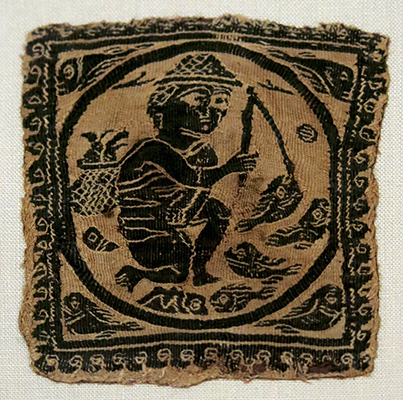
Coptic period: 3rd - 8th centuries AD
Nile scene
Fragments of a cloth: Nile scene with a young boy fishing in a boat, surrounded by fish and plants, 5th - 6th centuries AD.
Catalog: Wool on linen, Antinoöpolis, ÄS 4262
Photo: Don Hitchcock 2015
Source: Original, Ägyptischen Museum München
Text: © Ägyptischen Museum München

Coptic period: 3rd - 8th centuries AD
Orphrey
Orphrey from a tunic: busts and naked figures, framed by a wave scroll frieze, 5th - 6th centuries AD.
Catalog: Wool and linen, Antinoöpolis, ÄS 4253
Photo: Don Hitchcock 2015
Source: Original, Ägyptischen Museum München
Text: © Ägyptischen Museum München
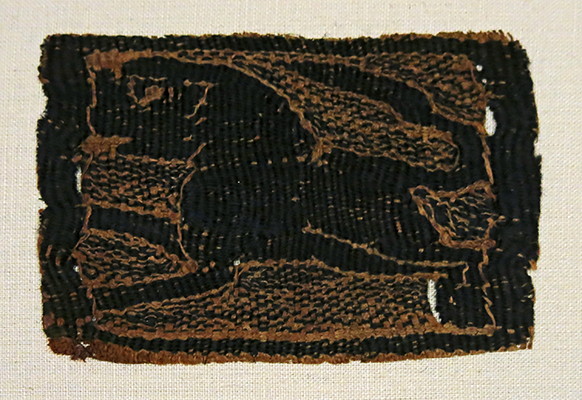
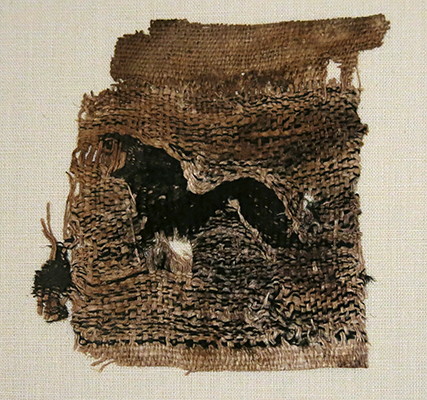
Coptic period: 3rd - 8th centuries AD
Fragments of decorative strips
Two fragments from decorative strips (Clavi) with running lions. 5th - 6th centuries AD.
Catalog: Wool on linen, ÄS 5518, ÄS 7255
Photo: Don Hitchcock 2015
Source: Original, Ägyptischen Museum München
Text: © Ägyptischen Museum München
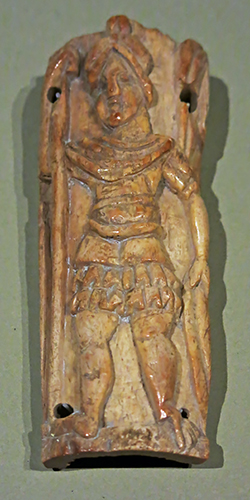
Coptic period: 3rd - 8th centuries AD
Relief Panel
Relief panel: Standing warrior, 6th century AD.
Catalog: Bone, ÄS 5914
Photo: Don Hitchcock 2015
Source: Original, Ägyptischen Museum München
Text: © Ägyptischen Museum München
Coptic period: 3rd - 8th centuries AD
Lion's Head
Water basin with a lion's head, 6th century AD.
Catalog: Marmor, Sakkara, Gl. 141
Photo: Don Hitchcock 2015, 2018
Source: Original, Ägyptischen Museum München
Text: © Ägyptischen Museum München
Coptic period: 3rd - 8th centuries AD
Trim
Fragments from a trim, cherubs below leaf ornaments, 6th century AD.
Catalog: Wool on linen, Antinoöpolis, ÄS 4247
Photo: Don Hitchcock 2015
Source: Original, Ägyptischen Museum München
Text: © Ägyptischen Museum München
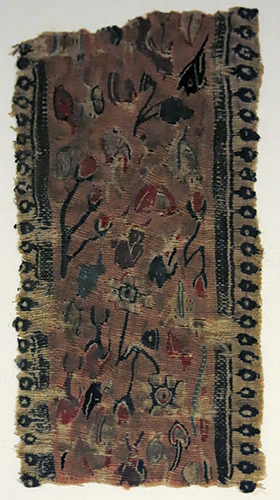
Coptic period: 3rd - 8th centuries AD
Plants and animals
Fragment of a decorative band (clavus) with plants and animals (fish, the head of a hare), 6th - 7th centuries AD.
Catalog: Wool on linen, Antinoöpolis, ÄS 4256
Photo: Don Hitchcock 2015
Source: Original, Ägyptischen Museum München
Text: © Ägyptischen Museum München
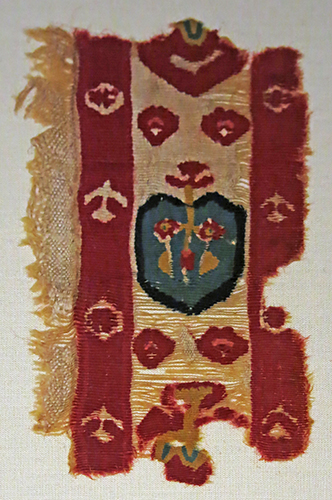
Coptic period: 3rd - 8th centuries AD
Trim
Fragment of a trim for a tunic or a large drapery, with leaf ornaments, 6th - 7th centuries AD.
Catalog: Wool, Antinoöpolis, ÄS 4263
Photo: Don Hitchcock 2015
Source: Original, Ägyptischen Museum München
Text: © Ägyptischen Museum München
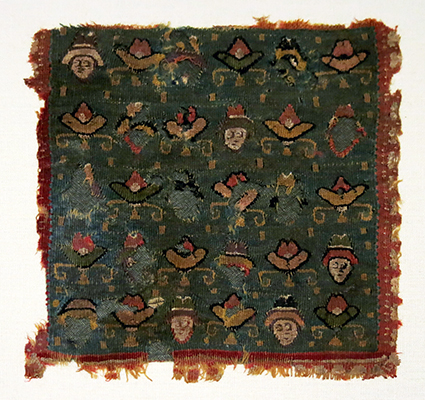
Coptic period: 3rd - 8th centuries AD
Patterned Panel
Panel with an alternating pattern, stylised heads and palmettes decorated with volutes ( spiral, scroll-like ornaments - Don ), 6th - 7th centuries AD.
Catalog: Wool, Antinoöpolis, ÄS 4254
Photo: Don Hitchcock 2015
Source: Original, Ägyptischen Museum München
Text: © Ägyptischen Museum München
Coptic period: 3rd - 8th centuries AD
Clavus
Fragment of a decorative band (clavus), with birds and pomegranates, 6th - 7th centuries AD.
Catalog: Wool on linen, Antinoöpolis, ÄS 4267
Photo: Don Hitchcock 2015
Source: Original, Ägyptischen Museum München
Text: © Ägyptischen Museum München
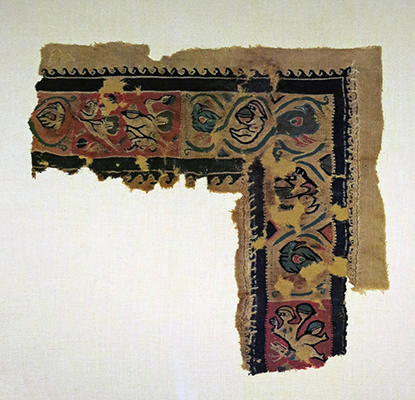
Coptic period: 3rd - 8th centuries AD
Orphrey
Orphrey from a garment, with birds and naked figures surrounded by scrollwork, 6th - 7th centuries AD.
Catalog: Wool and linen, Antinoöpolis, ÄS 4253
Photo: Don Hitchcock 2015
Source: Original, Ägyptischen Museum München
Text: © Ägyptischen Museum München
Coptic period: 3rd - 8th centuries AD
Band
Band with symmetrical decoration, stylised plants and human heads, 6th - 7th centuries AD.
Catalog: Wool on linen, Antinoöpolis, ÄS 4268
Photo: Don Hitchcock 2015
Source: Original, Ägyptischen Museum München
Text: © Ägyptischen Museum München

Coptic period: 3rd - 8th centuries AD
Sleeve
Fragment of a sleeve with a double trim, scrollwork framing human figures and various animals, 6th - 9th centuries AD.
Catalog: Wool on linen, Antinoöpolis, ÄS 4246
Photo: Don Hitchcock 2015
Source: Original, Ägyptischen Museum München
Text: © Ägyptischen Museum München
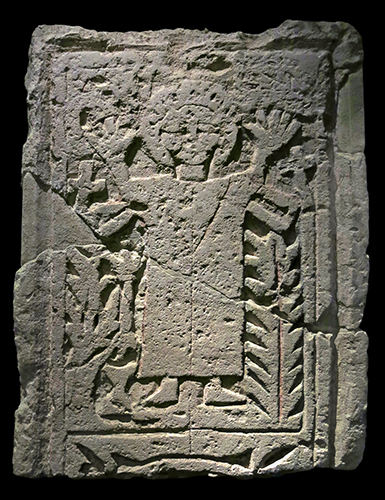
Coptic period: 3rd - 8th centuries AD
Stele
Praying between palm branches and crosses, symbols of the resurrection, seventh century AD.
Catalog: Limestone, from the region of Edfu, Gl. 147
Photo: Don Hitchcock 2015
Source: Original, Ägyptischen Museum München
Text: Museum card, © Ägyptischen Museum München
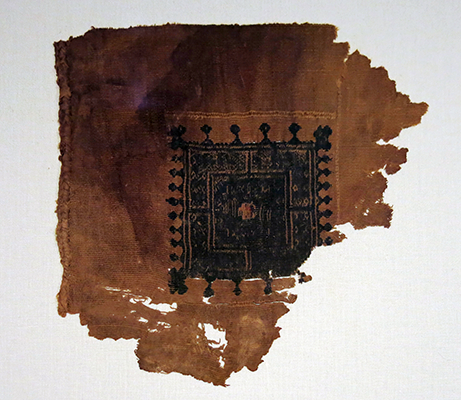
Coptic period: 3rd - 8th centuries AD
Orphrey
Orphrey with geometric ornaments, 7th - 8th centuries AD.
Catalog: Wool and linen, ÄS 61a
Photo: Don Hitchcock 2015
Source: Original, Ägyptischen Museum München
Text: © Ägyptischen Museum München

Coptic period: 3rd - 8th centuries AD
Sleeve trim
Sleeve trim from a tunic with abstract floral elements, 7th - 8th centuries AD.
Catalog: Wool and linen, ÄS 7254
Photo: Don Hitchcock 2015
Source: Original, Ägyptischen Museum München
Text: © Ägyptischen Museum München
Coptic period: 3rd - 8th centuries AD
Clavus
Fragment from a decorative band (clavus), stylised floral elements, 7th - 8th centuries AD.
Catalog: Wool on linen, ÄS 614
Photo: Don Hitchcock 2015
Source: Original, Ägyptischen Museum München
Text: © Ägyptischen Museum München
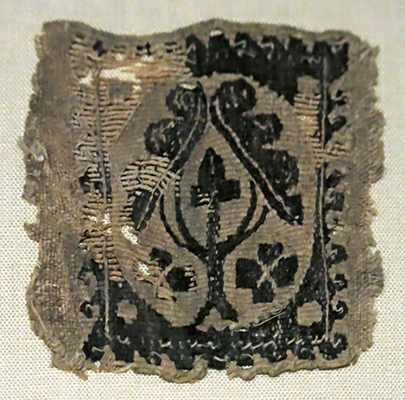
Coptic period: 3rd - 8th centuries AD
Medallion
Medallion with a tree amidst geometric decorations, 7th - 8th centuries AD.
Catalog: Wool on linen, ÄS 7243
Photo: Don Hitchcock 2015
Source: Original, Ägyptischen Museum München
Text: © Ägyptischen Museum München
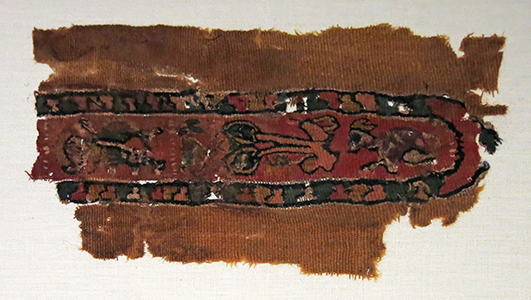
Coptic period: 3rd - 8th centuries AD
Clavus
Fragment from a decorative band (clavus), floral elements and hares, 7th - 8th centuries AD.
Catalog: Wool on linen, ÄS 7249
Photo: Don Hitchcock 2015
Source: Original, Ägyptischen Museum München
Text: © Ägyptischen Museum München
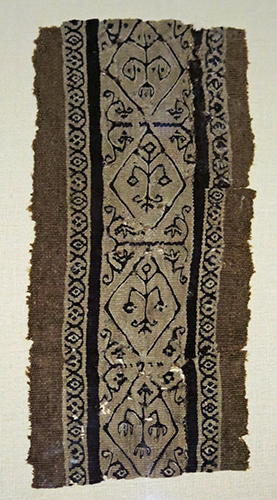
Coptic period: 3rd - 8th centuries AD
Clavus
Decorative band (clavus) with abstract floral elements, 7th - 8th centuries AD.
Catalog: Wool and linen, ÄS 7252
Photo: Don Hitchcock 2015
Source: Original, Ägyptischen Museum München
Text: © Ägyptischen Museum München

Coptic period: 3rd - 8th centuries AD
Fragment of a coverlet or wall hanging
Fragment of a coverlet or wall hanging with a rider and a medallion, 7th - 8th centuries AD.
Catalog: Wool and linen, ÄS 4228b
Photo: Don Hitchcock 2015
Source: Original, Ägyptischen Museum München
Text: © Ägyptischen Museum München
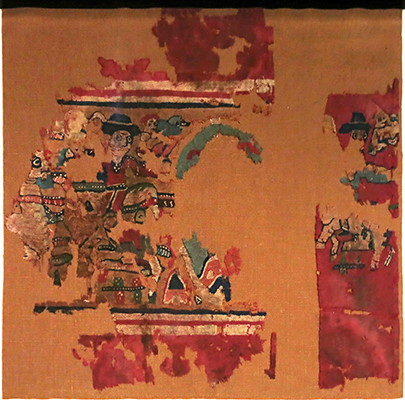
Coptic period: 3rd - 8th centuries AD
Fragment of a coverlet or wall hanging
Fragment of a coverlet or wall hanging depicting riders, 7th - 8th centuries AD.
Catalog: Wool and linen, ÄS 4228c-d
Photo: Don Hitchcock 2015
Source: Original, Ägyptischen Museum München
Text: © Ägyptischen Museum München
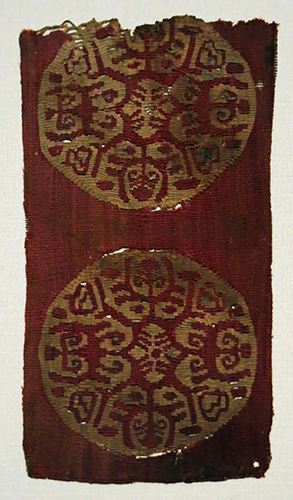
Coptic period: 3rd - 8th centuries AD
Medallions
Fragment from a band of cloth with ornamental patterns in two identical medallions, 7th - 8th centuries AD.
Catalog: Wool and Linen, ÄS 5519
Photo: Don Hitchcock 2015
Source: Original, Ägyptischen Museum München
Text: © Ägyptischen Museum München
Coptic period: 3rd - 8th centuries AD
Clavus and sleeve
Clavus and sleeve trim from a tunic, including palmettes ( an ornament of radiating petals like a palm leaf - Don )
and cornucopias, 7th - 8th centuries AD.
Catalog: Wool on linen, Antinoöpolis, ÄS 4260b, ÄS 4252
Photo: Don Hitchcock 2015
Source: Original, Ägyptischen Museum München
Text: © Ägyptischen Museum München


Coptic period: 3rd - 8th centuries AD
Clavus
Two fragments from a decorative band (clavus), showing stylised figures and fruit baskets, 7th - 8th centuries AD.
Catalog: Wool and linen, Antinoöpolis, ÄS 4251, ÄS 4255
Photo: Don Hitchcock 2015
Source: Original, Ägyptischen Museum München
Text: © Ägyptischen Museum München
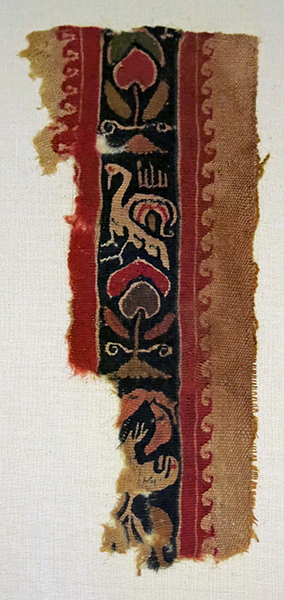
Coptic period: 3rd - 8th centuries AD
Clavus
Fragment of a decorative band (clavus). A swan or heron is shown, as well as a floral motif, 7th - 8th centuries AD.
Catalog: Wool and linen, Antinoöpolis, ÄS 4259
Photo: Don Hitchcock 2015
Source: Original, Ägyptischen Museum München
Text: © Ägyptischen Museum München
Coptic period: 3rd - 8th centuries AD
Clavus
Three fragments from a decorative band (clavus), including stylised figures and a wave scroll frieze, 7th - 8th centuries AD.
Catalog: Wool and linen, Antinoöpolis, ÄS 4258c, ÄS 4258a, ÄS 4264
Photo: Don Hitchcock 2015
Source: Original, Ägyptischen Museum München
Text: © Ägyptischen Museum München
Coptic period: 3rd - 8th centuries AD
Medallions
Fragment from a cloth, two medallions with dogs, 7th - 8th centuries AD.
Catalog: Wool on linen, ÄS 7247
Photo: Don Hitchcock 2015
Source: Original, Ägyptischen Museum München
Text: © Ägyptischen Museum München

Coptic period: 3rd - 8th centuries AD
Trim for a garment
Trim for a garment with floral and geometric elements, 7th - 9th centuries AD.
Catalog: Wool and linen, Antinoöpolis, ÄS 4243
Photo: Don Hitchcock 2015
Source: Original, Ägyptischen Museum München
Text: © Ägyptischen Museum München
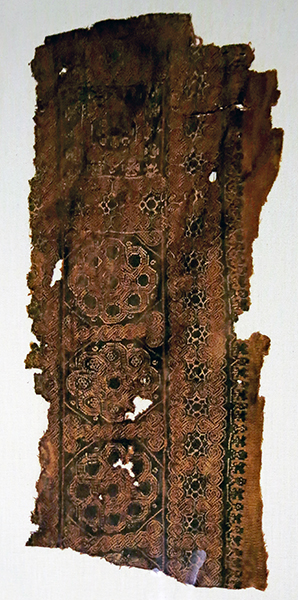
Coptic period: 3rd - 8th centuries AD
Plants and animals
Fragment of a decorative cloth with an ornamental pattern, 7th - 9th centuries AD.
Catalog: Wool on linen, ÄS 7253
Photo: Don Hitchcock 2015
Source: Original, Ägyptischen Museum München
Text: © Ägyptischen Museum München
Coptic period: 3rd - 8th centuries AD
Trim for a garment with floral and geometric elements
Trim and decorative band (clavus) from a tunic: diamond pattern with busts and birds, 8th - 9th centuries AD.
Catalog: Wool and linen, Antinoöpolis, ÄS 4261, ÄS 4265
Photo: Don Hitchcock 2015
Source: Original, Ägyptischen Museum München
Text: © Ägyptischen Museum München

Coptic period: 3rd - 8th centuries AD
Medallion
Fragment of a tunic, medallion with bird and animal motifs, 8th - 9th centuries AD.
Catalog: Wool on linen, Antinoöpolis, ÄS 4249
Photo: Don Hitchcock 2015
Source: Original, Ägyptischen Museum München
Text: © Ägyptischen Museum München
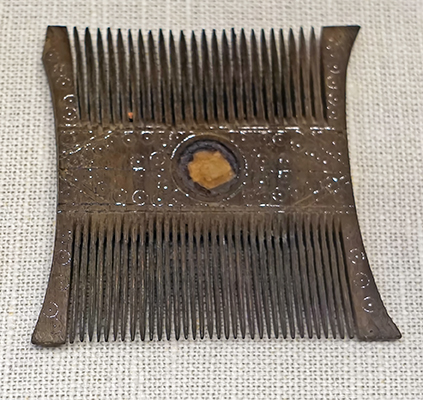
Coptic period: 3rd - 8th centuries AD
Double Comb
Circa 200 to 600 AD.
Wood with silver wire inlay Lg 7 cm, Br. 6 cm
Combs were already found in prehistoric graves for grooming and smoothing as well as for pinning up long hair.
The tines could be arranged in one or, as here, in two rows. The material used was mainly bone, ivory and wood. The short shape of the combs - in contrast to the long shape we often use - has been preserved over the millennia.
Very often the parts intended to be held by the hand are decorated, often the decoration has an apotropaic (aversion of evil influences or bad luck) character. In the case of this example, which dates back to the post-Pharaonic period, the silver wire inlays are purely decorative. The circular inlay (probably made of ivory) is lost.
Catalog: Wood and silver, origin unknown, Inv. nr. 4512
Photo: Don Hitchcock 2018
Source and text: Original, Museum August Kestner, Hannover
Additional text: Paper Catalogue, Museum August Kestner, Hannover
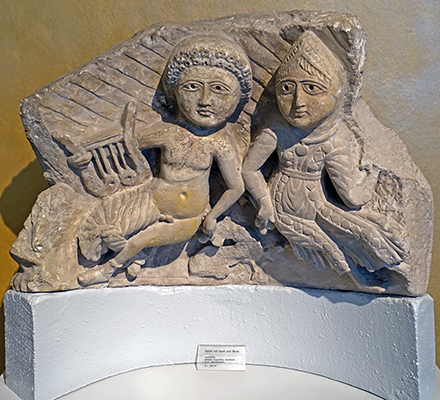
Coptic period: 3rd - 8th centuries AD
Apollo and Muse
Relief with Apollo and Muse
5th - 6th century AD.
Catalog: Limestone, Ahnas (Egypt), Inv. nr. 1966.90
Photo: Don Hitchcock 2018
Source and text: Original, Museum August Kestner, Hannover
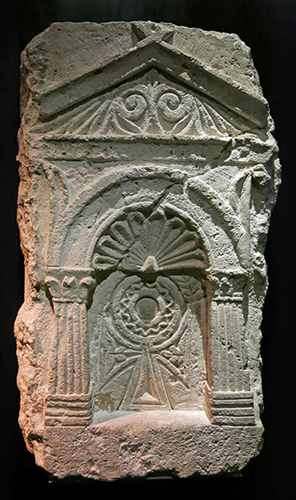
Coptic period: 3rd - 8th centuries AD
Tomb Stela
Tomb stela with a Coptic cross, circa 7th century AD.
Catalog: Limestone, Gl. 134
Photo: Don Hitchcock 2015
Source: Original, Ägyptischen Museum München
Text: © Ägyptischen Museum München
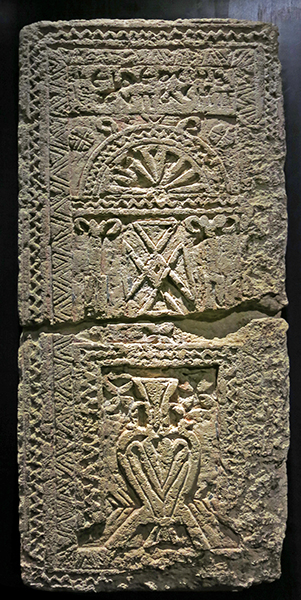
Coptic period: 3rd - 8th centuries AD
Small Shrine
An aedicule, a small shrine, intended to frame, shelter and honour a holy object, in this case bearing a Maltese cross, circa 7th century AD.
Catalog: Limestone, Gl. 144a-b
Photo: Don Hitchcock 2015
Source: Original, Ägyptischen Museum München
Text: © Ägyptischen Museum München
Additional text: Wikipedia
Islamic Period
Islamic period: 640 AD - 1 517 AD
The Palace of Mshatta - Front Entrance Walls
The ruins of the palace of Mshatta (Arabic for winter camp) are located thirty kilometres south of Amman, the Jordanian capital. Construction of the palace, which probably started during the brief reign of the Caliph al-Walid II (743 -744 AD), was not completed as he was murdered early on and the palace destroyed shortly after by an earthquake. Mshatta was constructed as a palatial complex with a square enclosure wall. The entrance was located on the south side, where part of the facade, 47 m long, was decorated with grapevines. A peculiar feature of the facade is the change in motifs: the triangular fields on the left section of the facade show the peaceful coexistence of animals and mythical creatures.
The reproductions of living creatures end at the right gate-tower, probably due to the presence of the mosque behind this part of the facade, where such
imagery was forbidden. Sculptural fragments from the throne room suggest that the interior of the caliphal palace once displayed a wealth of figurative imagery, thus placing Mshatta in the tradition of the Umayyad palaces in the region of Syria and Palestine.
The main part of the decorated facade was presented to the German Kaiser Wilhelm II by the Ottoman Sultan Abd al-Hamid II; it has been in the Berlin museums since 1903. As one of the most important architectural monuments, it has been on view to museum visitors ever since the Kaiser Friedrich Museum opened in 1904. Since 1932 the facade has been on exhibition at the Pergamon Museum.
Catalog:
Photo: Don Hitchcock 2015
Source: Original, Pergamonmuseum, Staatliche Museen zu Berlin
Text: © Pergamonmuseum, Staatliche Museen zu Berlin
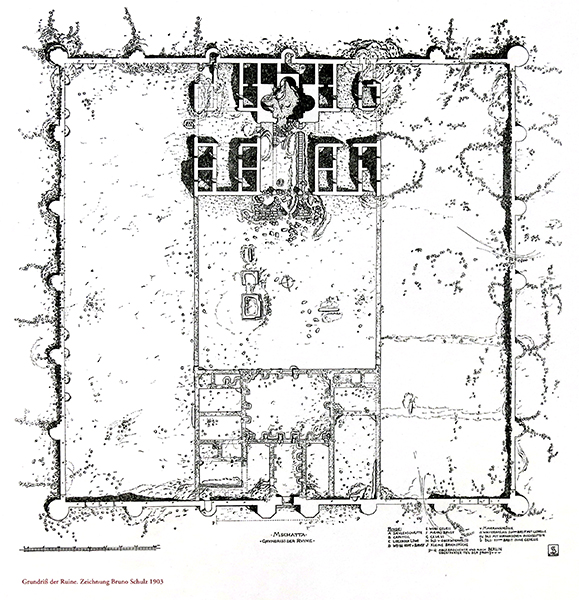
Ground plan of the ruin.
Drawing: Bruno Schulz 1903
Rephotography: Don Hitchcock 2015
Proximal source: Poster, Pergamonmuseum, Staatliche Museen zu Berlin
Original source: Laban (1904a), plate 18.
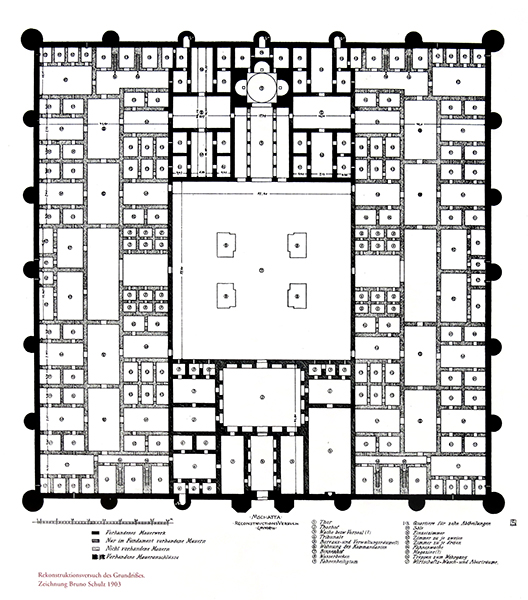
Ground plan reconstruction.
( note that the towers at the gate are octagonal in design, though missing the inner three sides. This design allowed a larger and more convenient area on top of the towers for soldiers to assemble and defend the gates.
The towers on the corners of the palace are almost complete circles, which is a design which allows for better defence from sappers undermining the foundations, while the towers on the curtain walls are semicircles, allowing plenty of room for soldiers, but with the same advantage against sappers.
The whole structure is square, which uses the minimum amount of stone and other structures for the maximum area within the palace for the minimum perimeter to defend, unless the entire palace were to be circular, which brings its own problems of space and organisation and ease of construction - Don )
Drawing: Bruno Schulz 1903
Rephotography: Don Hitchcock 2015
Proximal source: Poster, Pergamonmuseum, Staatliche Museen zu Berlin
Original source: Laban (1904b), plate 24.
Front Gate Towers and Curtain Wall reconstruction.
( note that I have modified the ( thumbnail ) image here to show the parts of the gate towers and curtain wall which were salvaged from the ruins of the palace. As always the full size ( and unaltered ) image is available by clicking on the image, when the full size image of the unmodified reconstruction will appear, should you wish to see it - Don )
Drawing: Bruno Schulz 1903
Rephotography: Don Hitchcock 2015
Proximal source: Poster, Pergamonmuseum, Staatliche Museen zu Berlin
Original source: Laban (1904c), plate 20.
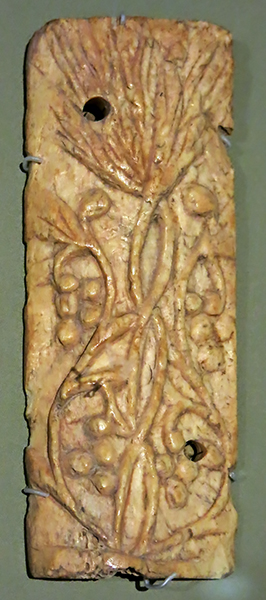
Islamic period: 640 AD - 1 517 AD
Relief Panel
Moulding with grape vines and bunches of grapes, 9th - 10th centuries AD.
Catalog: Bone, ÄS 5940
Photo: Don Hitchcock 2015
Source: Original, Ägyptischen Museum München
Text: © Ägyptischen Museum München
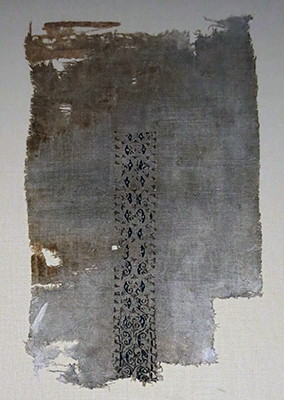
Islamic period: 640 AD - 1 517 AD
Linen cloth
Fragment of cloth with a band of embroidery, 10th - 12th centuries AD.
Catalog: Linen, ÄS 61f
Photo: Don Hitchcock 2015
Source: Original, Ägyptischen Museum München
Text: © Ägyptischen Museum München

Islamic period: 640 AD - 1 517 AD
Silk cloth
Fragment of fine silk cloth with a striped pattern, 13th - 14th centuries AD.
Catalog: Silk, ÄS 61e
Photo: Don Hitchcock 2015
Source: Original, Ägyptischen Museum München
Text: © Ägyptischen Museum München
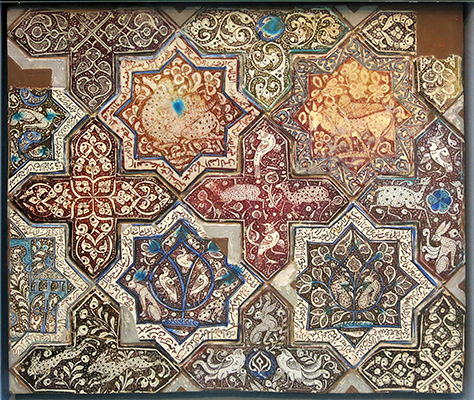
Islamic period: 640 AD - 1 517 AD
Tiles
Field of cross and star tiles, Iran (Kazan), late 13th century.
Quartz ceramics, underglaze and lustre painting
The lustre colours on early Islamic and Italian majolica from the 9th to the 16th centuries are emulsions of metal sulfates or oxides, mixed with ochre, which were applied in acidic solution to the glaze formed during the first firing and melted in a smoothing firing (overglaze firing ) at moderate temperature.
One tile dated 697 AH, 1 297 AD / 1 298 AD.
Catalog: Ceramic tiles, Inv. No I. 3866 a-c, f-g, I. 3905 a-b, I. 1312, I. 5997, I. 6909, Cass
Photo: Don Hitchcock 2015
Source: Original, Pergamonmuseum, Staatliche Museen zu Berlin
Text: © Pergamonmuseum, Staatliche Museen zu Berlin
Additional text: Wikipedia
Islamic period: 640 AD - 1 517 AD
Tiles
Field of cross and star tiles, Iran, 13th - 14th century.
Quartz frit, opaque white glaze, blue and turquoise painting, lustre painting. Embossed type, opaque turquoise glaze.
Height 410 mm, width 1045 mm, depth 55 mm.
A tile field, which is composed of ten eight-cornered star tiles and four cross tiles. The upper row of star tiles shows the following lustre paintings from right to left: a standing figure that turns to the left and is surrounded by flowers (I.1312); two facing birds, surrounded by several vegetable motifs (I.1311); a composition of flowers and tendrils framed by a luster inscription in which verses are quoted from the Koran; the depiction of two facing parrots (I. 3866 f), framed by a white inscription on a blue background and finally the depiction of a kneeling person sitting under a tent (I. 3866 b).
The lustre paintings on the tiles in the lower row show from right to left: the representation of two deer and a crane, which are framed by a white inscription on a blue background (I. 3866 g); a floral composition, which is also framed by a white inscription on a blue background (I. 3866 d); the representation of a flying phoenix (I. 3866 c); a running gazelle surrounded by flowers (I. 3866 a); and a greyhound (?) followed by a gazelle (I.6909). The last three representations are surrounded by a frame made of blue vegetable motifs.
The four cross tiles in relief are all covered with an opaque turquoise glaze and, apart from the tile on the left, show a flower in the centre, which is surrounded by tendrils and running deer and rabbits. The left cross tile again shows four lotus flowers arranged around a flower. (I. 3905 a, I. 1547, I. 3905 b, I. 5997)
The tile field was only put together at the end of the 19th - early 20th centuries. It is possible that the cross tiles date from the 19th century.
Catalog: Ceramic tiles, Inv. No I. 3866 a
Photo: Don Hitchcock 2015
Source: Original, Pergamonmuseum, Staatliche Museen zu Berlin
Text: © Pergamonmuseum, Staatliche Museen zu Berlin
Additional text: Wikipedia
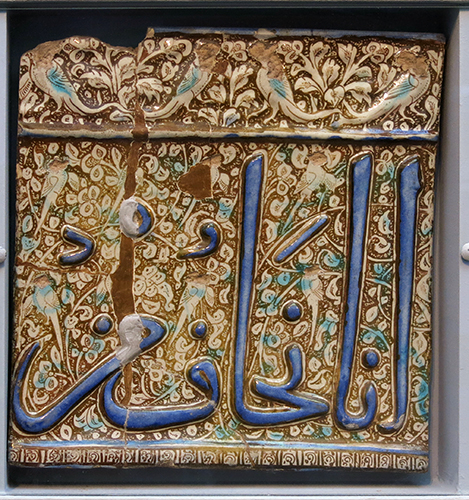
Islamic period: 640 AD - 1 517 AD
Inscription Frieze
Fragment of an inscription frieze made of quartz frit, dated AH 707, 1308 AD
A frit is a ceramic composition that has been fused, quenched, and granulated. Frits form an important part of the batches used in compounding enamels and ceramic glazes.
Quartz frit, embossed, opaque white glaze, blue and turquoise paint, and lustre painting, from Iran.
Dimensions: height 370 mm, width 355 mm.
Above the blue painted inscription in relief runs a border in relief with white recessed depictions of birds and flowering shrubs on a lustre background. The inscription in the Thuluth style stands out against the lustre-painted background with white vine motifs and birds. The lower edge is decorated with a narrow band. The text is part of a verse from the Koran.
Similar inscription friezes are known from the city of Kashan, which was one of the most important production centres of lustre ceramics in Iran from the 12th to the 14th century. This type of architectural ceramics in relief decorated not only prayer niches and tombstones but also walls of mosques and other monumental buildings.
Catalog: Inscription frieze, Inv. No I. 3899
Photo: Don Hitchcock 2015
Source: Original, Pergamonmuseum, Staatliche Museen zu Berlin
Text: © Pergamonmuseum, Staatliche Museen zu Berlin, http://www.smb-digital.de/
Additional text: Wikipedia

Islamic period: 640 AD - 1 517 AD
Carpet
Cover of the binding of a Koran with throne verse (Koran, Sura 2, verse 255), end of the 14th Century AD.
The verse speaks about how nothing and nobody is regarded to be comparable to Allah.
Leather, blind pressed ( the opposite of embossing - Don ) and gold plated.
Catalog: Leather, Egypt, Cairo, Inv.-Nr. I. 5622
Photo: Don Hitchcock 2015
Source: Original, Pergamonmuseum, Staatliche Museen zu Berlin
Text: © Pergamonmuseum, Staatliche Museen zu Berlin
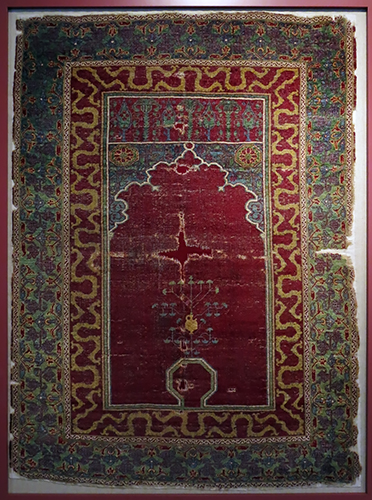
Islamic period: 640 AD - 1 517 AD
Prayer Rug
Prayer rug with fountain and tree motif, 16th century AD.
Catalog: Wool, Egypt, Cairo, KGM 1888,30
Photo: Don Hitchcock 2015
Source: Original, Pergamonmuseum, Staatliche Museen zu Berlin
Text: © Pergamonmuseum, Staatliche Museen zu Berlin
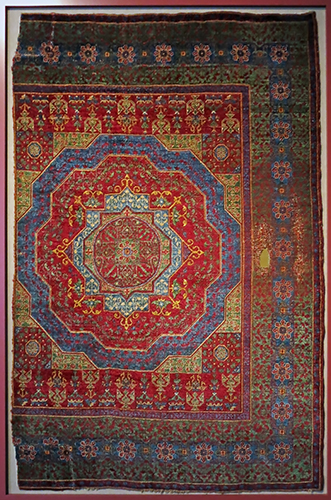
Islamic period: 640 AD - 1 517 AD
Carpet
Carpet (fragment) with central medallion, 16th century AD.
Catalog: Wool, Egypt, Cairo, KGM 1891,26
Photo: Don Hitchcock 2015
Source: Original, Pergamonmuseum, Staatliche Museen zu Berlin
Text: © Pergamonmuseum, Staatliche Museen zu Berlin
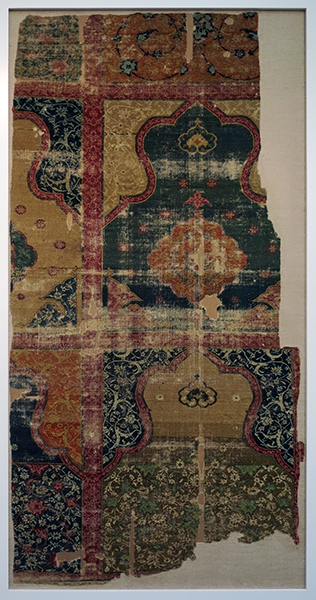
Islamic period: 640 AD - 1 517 AD
Prayer Rug
Prayer Rug (Fragment), Iran, early 16th century.
Catalog: Wool, knotted on cotton Inv.-Nr. I. 66/62
Photo: Don Hitchcock 2015
Source: Original, Pergamonmuseum, Staatliche Museen zu Berlin
Text: © Pergamonmuseum, Staatliche Museen zu Berlin
References
- Deacon D., McFarland C., 2014: War Imagery in Women's Textiles: An International Study of Weaving, Knitting, Sewing, Quilting, Rug Making and Other Fabric Arts, McFarland, 18 Jun. 2014 - Art - 260 pages
- Ellis M., 2001: Embroideries and Samplers from Islamic Egypt, Ashmolean Museum, 2001 - Design - 95 pages
- Laban F., (ed.) 1904a: Jahrbuch der Königlich Preussischen Kunstsammlungen, Berlin 1904 Volume 25 Publisher: G. Grote'sche Verlagsbuchhandlung, plate following page 224 in the original, plate 18, page 326/670 from https://archive.org/details/jahrbuchderkonig25unse_0/page/n3/mode/2up
- Laban F., (ed.) 1904b: Jahrbuch der Königlich Preussischen Kunstsammlungen, Berlin 1904 Volume 25 Publisher: G. Grote'sche Verlagsbuchhandlung, plate following page 224 in the original, plate 24, page 348/670 from https://archive.org/details/jahrbuchderkonig25unse_0/page/n3/mode/2up
- Laban F., (ed.) 1904c: Jahrbuch der Königlich Preussischen Kunstsammlungen, Berlin 1904 Volume 25 Publisher: G. Grote'sche Verlagsbuchhandlung, plate following page 224 in the original, plate 20, page 334/670 from https://archive.org/details/jahrbuchderkonig25unse_0/page/n3/mode/2up
Back to Don's Maps
 Back to Archaeological Sites
Back to Archaeological Sites
 Back to Egypt Index Page
Back to Egypt Index Page
